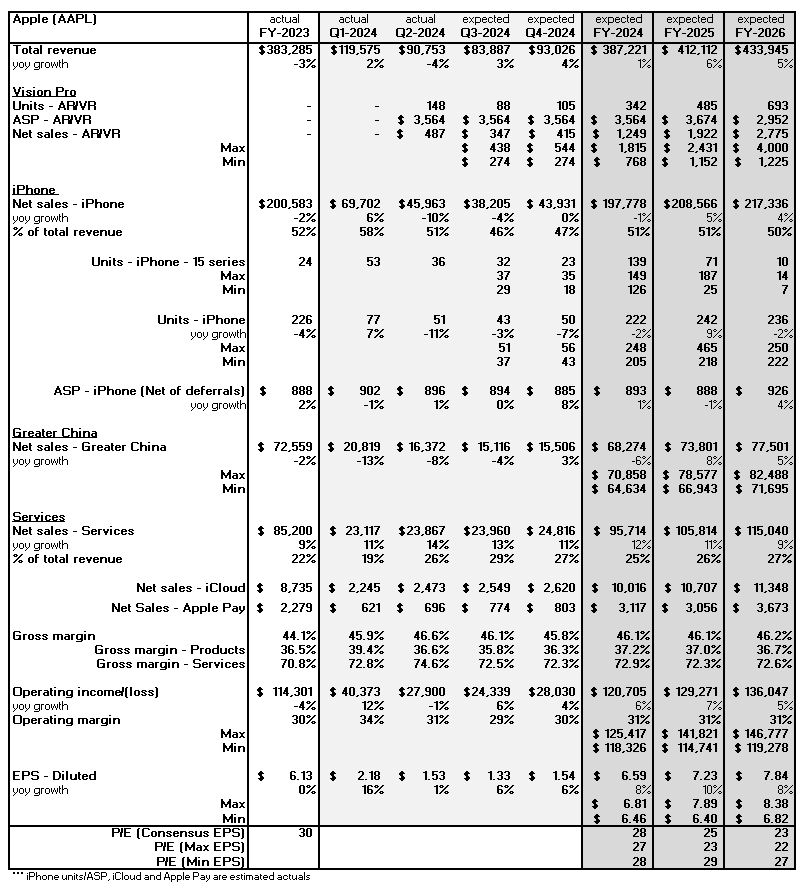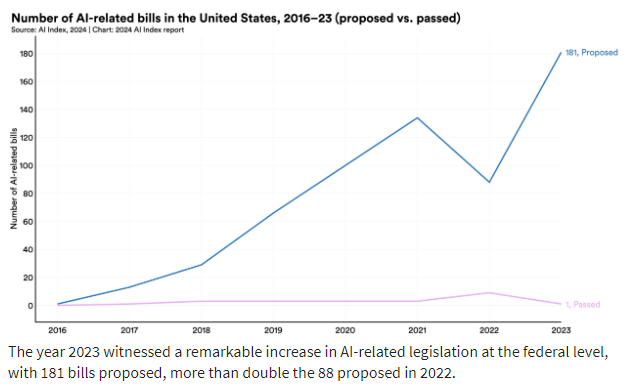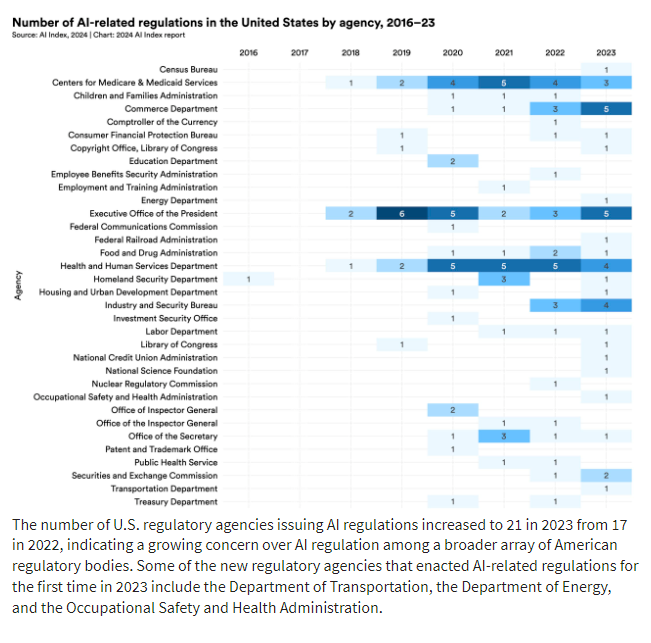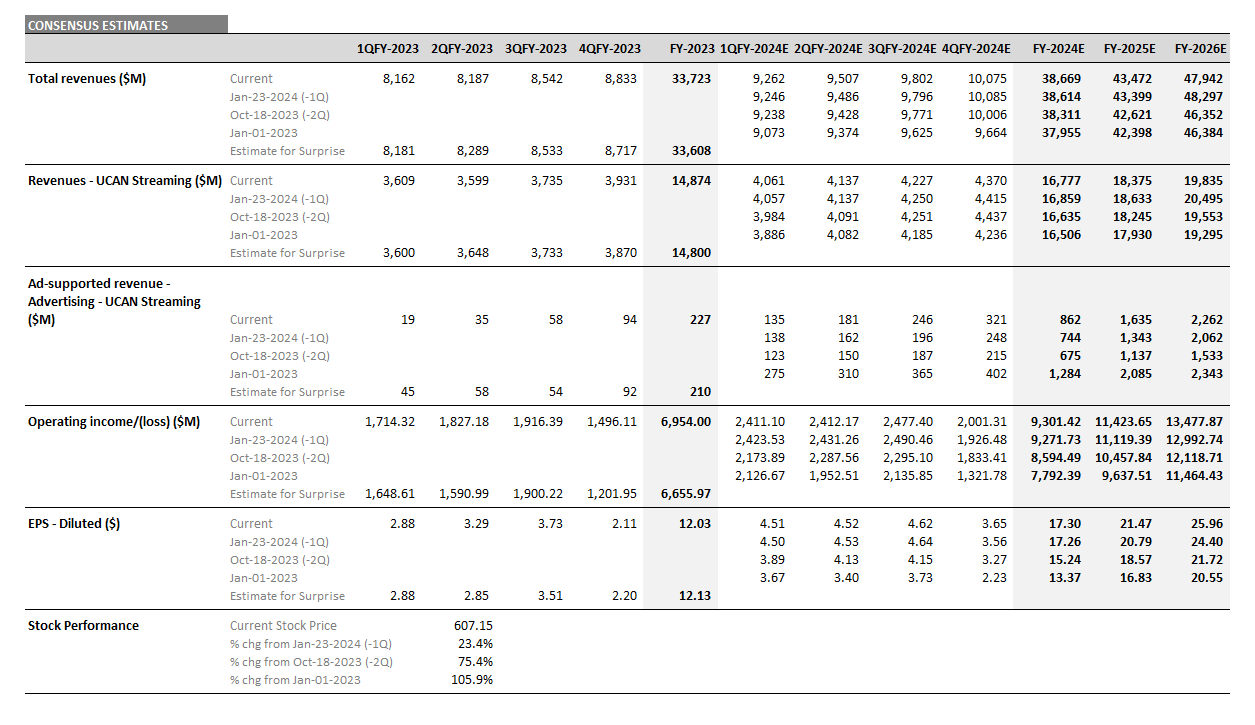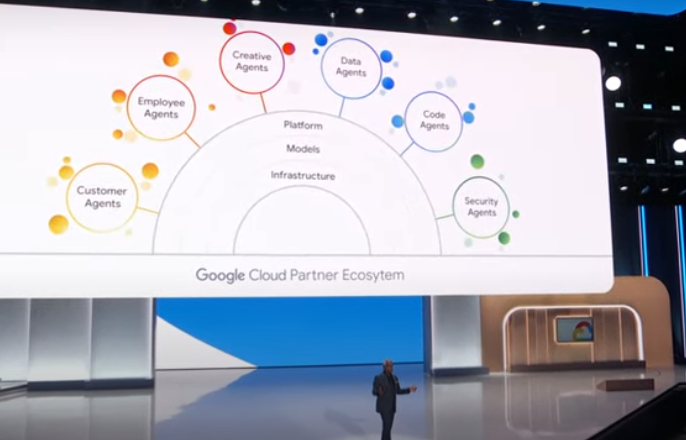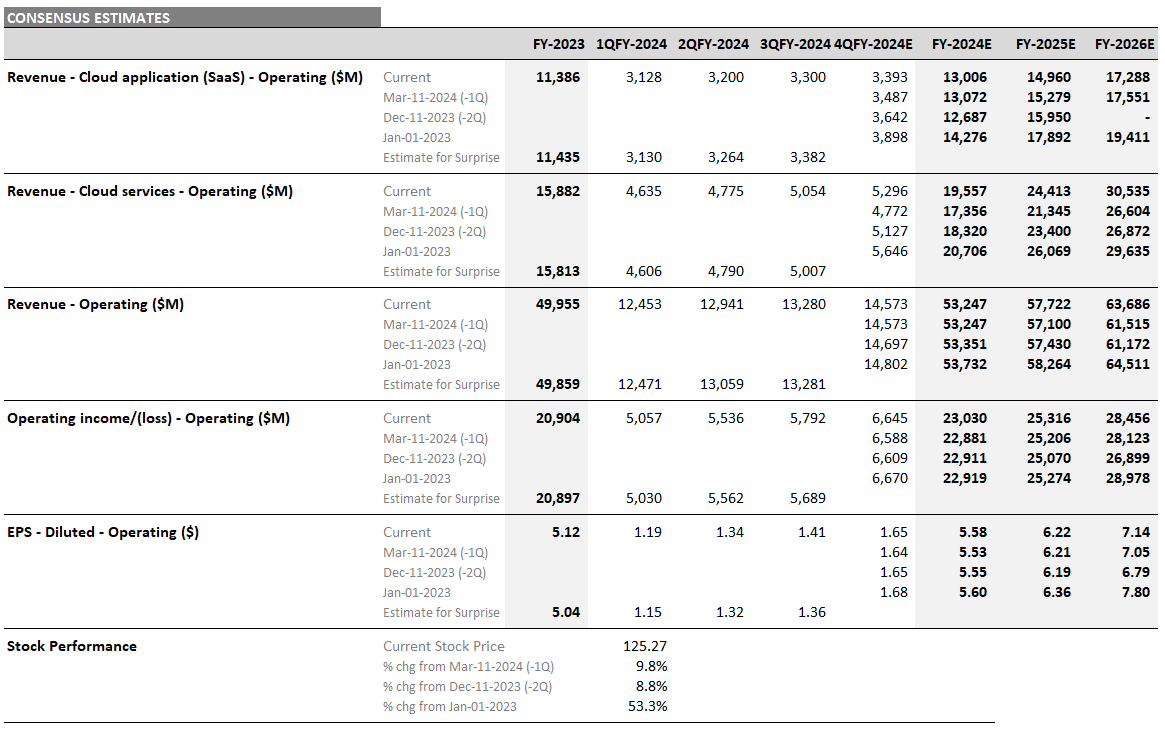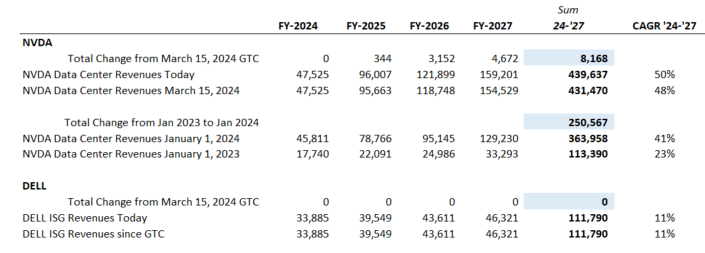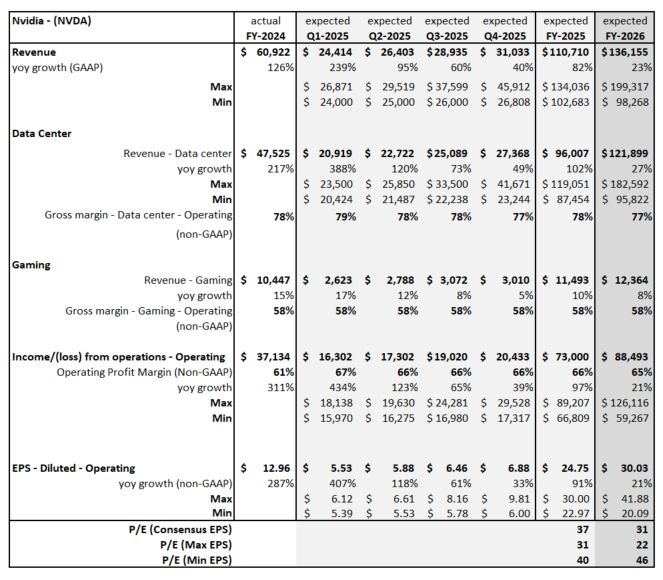AI and Search: What’s Next for Google?
At last week’s Google I/O developers conference, Alphabet (NASDAQ: GOOGL) unveiled new AI capabilities for Search. Is Google Search revenue growth sustainable in an AI world?
What’s next for Search?
Alphabet has long dominated the digital advertising revenue space through the strength of its Google Search. The company generated $175 billion from Search in FY 2023 or 57% of total revenue. Looking ahead, analysts expect Search to grow nearly $75 billion to reach $250 billion by the end of FY 2027, which drives the overall Services segment. Services still drive nearly 100% of the operating income for Alphabet.
With the expansion of ChatGPT, concerns have emerged about Google’s ability to maintain its dominant position in Search and with advertisers. There is discussion that users may prefer results that are more curated and do not force-rank sponsored links to the top of a user’s search results. Without the expected growth of Search, Alphabet’s Services operating income growth could be at risk, putting additional pressure on the company to increase the Cloud margin and reduce losses in its Other Bets and Unallocated segments to maintain its current valuation. Based on Visible Alpha consensus of 20x P/E and a $197 price target, Alphabet’s projected 2025 P/E ranges from 17x to 22x, depending on the earnings growth assumptions.
Figure 1: Consensus estimates for Alphabet

Source: Visible Alpha consensus (May 16, 2024). Stock price data courtesy of FactSet. Alphabet’s current stock price is as of the market close on May 15, 2024.
Search updates from Google I/O
According to Alphabet CEO Sundar Pichai, the greatest areas of investment and innovation are going to be in Search. In the Gemini era, AI is set to expand Search’s capabilities. This investment is likely needed for Alphabet to maintain its dominance in advertising. Questions are emerging about the sustainability of Google’s business model in Search as ChatGPT’s features and capabilities infringe on Google’s turf.
Liz Reid, VP of Search, highlighted that the volume of online facts and Google’s ranking system combined with Gemini will dramatically expand Search’s possibilities. AI Overviews rolled out on May 15, and Google will soon release planning, brainstorming, and troubleshooting with video capabilities. Will these enhancements be enough to keep users and ad revenues growing in line with current expectations?
Figure 2: Google’s new AI-generated search results
At both last week’s Google I/O conference and Google Marketing Live 2023, the Company showed prototypes adding images and AI-generated stories to its search results. We compared the results presented last year with what is currently available and was newly presented. Google seems to have pivoted a bit on their approach to AI integration (see Figures 3, 4, and 5).
Last year, Google highlighted that AI-generated stories would be coming soon. However, these have not materialized in the way initially showcased. Instead, the emphasis remains on surfacing “Sponsored” search results first. This is likely to preserve the premium that advertisers pay to appear at the top of the search ranking. When the questions are more generic, however, Google’s new AI Overview feature appears, returning a summary and a list of various unsponsored links. In ChatGPT-4, users can have an experience similar to Google, but without the sponsored links dominating the results. How will the Search results evolve and potentially impact the ad revenue model going forward?
Over the next few months, the company will focus on the integration of Gemini to Search. Going forward, the success of this integration may be a critical factor for Google, both to maintain its stronghold in Search and continue growing its advertising revenues to meet expectations.
Figure 3: Google’s 2023 AI-generated story capability
Figure 4: Google’s current search results for Outdoor Activities in Maui
Figure 5: Google’s new AI overview results asking “What is Maui like?”
Nvidia (NVDA) Earnings Preview: Fiscal Q1 2025
Nvidia Corp. (NASDAQ: NVDA) will report fiscal Q1 2025 results on Wednesday, May 22, 2024, after the market close. Here are the key numbers that we’re watching.
Figure 1: Nvidia – consensus expectations for Q1 2025, past earnings surprises, revisions, and CAGR

Source: Visible Alpha consensus (May 15, 2024). “Previous Surprises” indicate the direction that specific line items beat or missed. “Consensus Revisions” show the trajectory of line items from a given date.
Nvidia’s Q1 2025 earnings preview
According to Visible Alpha consensus, total revenues of $24.7 billion expected for fiscal Q1 2025 have not moved much from fiscal Q4 2024 earnings in February. Overall growth continues to be driven by optimism about the strength of Nvidia’s Data Center segment. This segment has seen its expected top line performance for Q1 increase from a mere $5.1 billion in January 2023 to its current projection of $21.2 billion, up over 4x. This revenue surge has been driven by strong demand for its GPUs from cloud service providers, and the move to accelerated computing in the data centers for AI.
More recently, the Data Center segment’s expected revenues in Q1 moved slightly higher from $20.6 to $21.2, according to consensus. While the pace of analysts’ upward revisions to the Data Center segment has stabilized since the Q3 release in late November, it will be important to see how Nvidia guides the market for Q2 and FY 2025, and to what extent higher pricing and volumes will be expected to continue.
Currently, there is significant debate about the performance of the Data Center segment. Based on Visible Alpha consensus, this business is projected to generate $23.2 billion in revenues in Q2 2025. For FY 2025, Visible Alpha consensus for this segment has increased an additional $4.2 billion to $97.7 billion since the Q4 2024 release in February. However, the estimates now range from $87.5 billion to $117.5 billion, a significant narrowing from the February range of $65.4 billion to $121.2 billion. The FY 2026 expected Data Center revenue range from $96.4 billion to $187.0 billion remains significant, causing expected FY 2026 P/Es to range from 20x to 45x.
The stock has traded up an incredible 83% since the November release, and is up around 35% since the February release. Could the Q1 release provide the next positive catalyst for the stock or are expectations largely priced in for now?
Figure 2: Nvidia consensus estimates
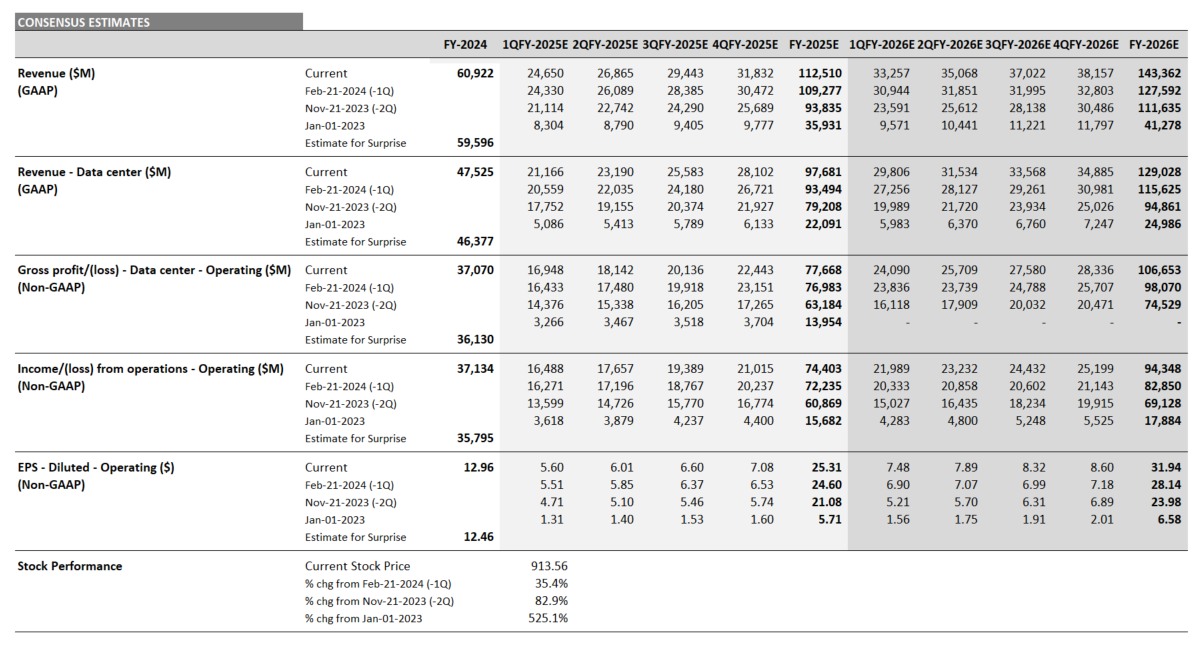
Source: Visible Alpha consensus (May 15, 2024). Stock price data courtesy of FactSet. Nvidia’s current stock price is as of the market close on May 14, 2024.
Figure 3: Nvidia’s key financial items

Source: Visible Alpha consensus (May 15, 2024). Stock price data courtesy of FactSet. Nvidia’s current stock price is as of the market close on May 14, 2024.
Also check out our latest AI Monitor for a view of Nvidia’s AI-exposed revenues and growth potential.
Big Tech Earnings Review: Meta, Microsoft, Alphabet, Amazon & Apple
Big Tech companies — Meta (NASDAQ: META), Microsoft (NASDAQ: MSFT), Alphabet (NASDAQ: GOOGL), Amazon (NASDAQ: AMZN), and Apple (NASDAQ: AAPL) — reported their latest earnings in April-May 2024. Here’s a recap of those earnings releases, some key takeaways, and the resulting shifts in analysts’ estimates, according to Visible Alpha consensus.
Summary of earnings
For the mega-cap tech companies, this earnings season has been dominated by the momentum around generative AI (GAI). The dynamics of juggling talent and investment in multiple layers of the stack add complexity to the business fundamentals. The mega-cap firms are all, in their own way, enhancing aspects of infrastructure, building off the existing large language models (LLMs) and supporting an environment for creating new GAI apps.
As more and more enterprise data moves to the cloud, Cloud Service Providers are continuing to invest heavily. Competition seems to be increasing, with Microsoft declaring Azure a sharetaker and demand continuing to exceed supply. However, adoption is going to be transformative both for enterprises and individuals, which may prove challenging in some cases. What will be the catalyst that moves us to a fully scaled GAI world?
See our latest AI Monitor for more on the current state and projected growth of the core AI industry.
Meta Platforms’ Q1 2024 earnings
According to Visible Alpha consensus, total revenues for Q1 came in inline with expectations at $36.5 billion, driven by solid performance in the Family of Apps segment, especially in the U.S. and Europe. However, operating profit slightly exceeded expectations by around $400 million at $13.8 billion, driven by resilience in the Family of Apps. The company’s revenue outlook for Q2 was in line with expectations, but full-year expense guidance was higher than expectations by $1 billion, as the expense range skewed higher. In addition, CEO Mark Zuckerberg highlighted that the company’s optimism and ambitions in AI are going to drive expenses higher for longer than expected.
For 2024, post-earnings expectations for operating income from the Family of Apps have declined by $1.5 billion to $80.0 billion, driven by higher expenses in the business. In addition, the projected losses from Reality Labs for 2024 have also increased further since the earnings release. Is the year of efficiency officially over?
Meta’s stock has been an outperformer since last quarter, up more than 18%, but has pulled back a bit on the higher expense guidance. Could some new information come out of Meta’s shareholder meeting on May 29?
Figure 1: Meta Platforms revisions
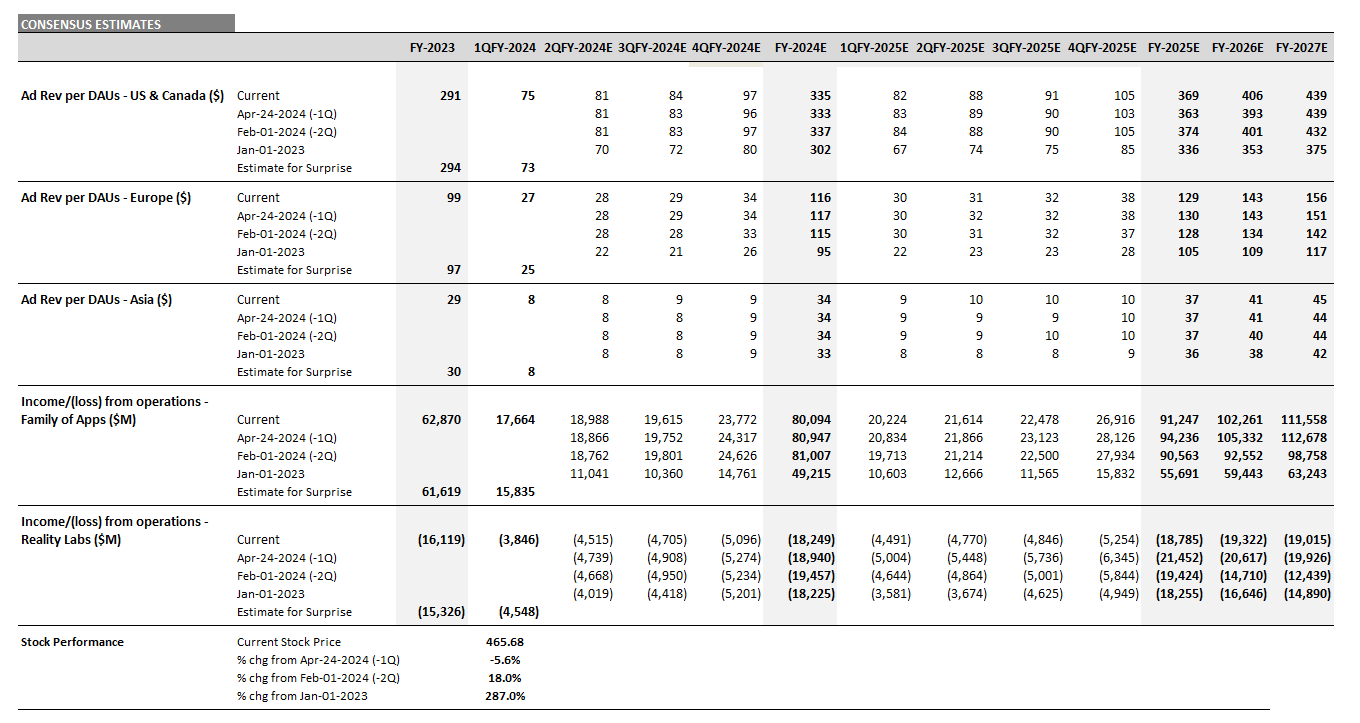
Source: Visible Alpha consensus (May 7, 2024). Stock price data courtesy of FactSet. META’s current stock price is as of the market close on May 6, 2024.
Figure 2: Meta Platforms consensus estimates
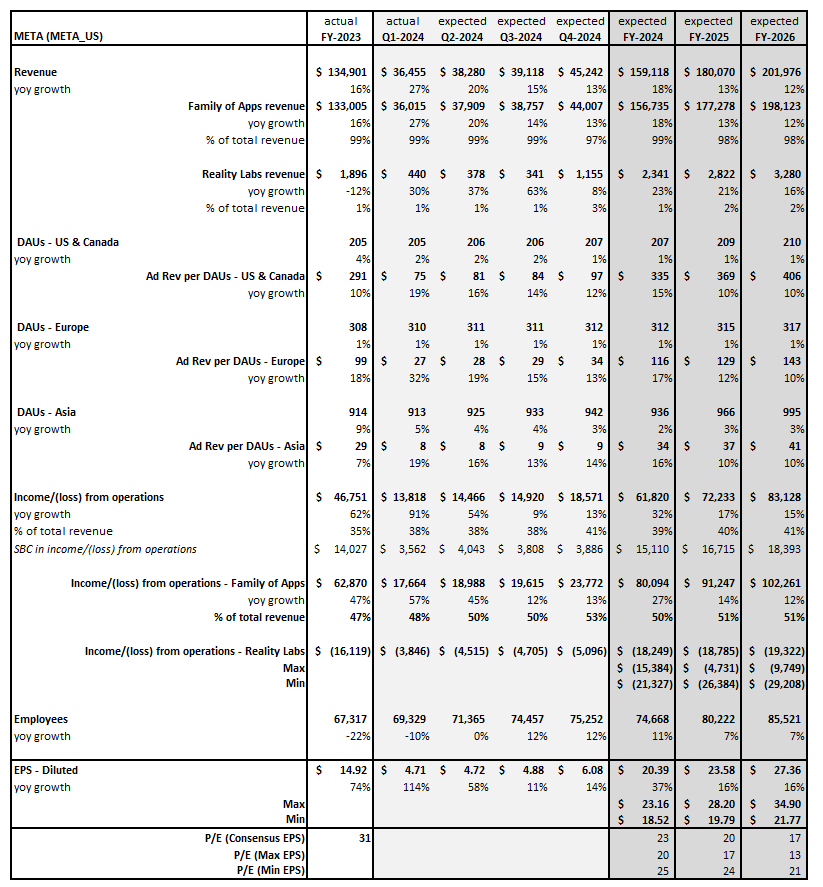
Source: Visible Alpha consensus (May 7, 2024). Stock price data courtesy of FactSet. META’s current stock price is as of the market close on May 6, 2024.
Microsoft’s Fiscal Q3 2024 earnings
According to Visible Alpha consensus, total revenues for Q3 exceeded expectations by $1 billion, coming in at $61.9 billion since October, driven by the Intelligent Cloud segment, which made up over 40% of total revenues and comprised most of the beat. The profitability of the Intelligent Cloud business has been a source of debate among analysts. Ahead of Q3 2024, a consensus of 14 analysts for the Intelligent Cloud segment’s operating profit margin was 45%, but Microsoft delivered a 47% margin, beating consensus by 200 basis points.
Management highlighted that near-term AI demand is outpacing capacity and that Azure has been taking share. For 2024, Intelligent Cloud post-earnings consensus revenue increased by $2 billion and operating profit by $3 billion to reflect a higher margin assumption, driven by Azure. Will the generative AI investments continue to drive upside to fundamentals in Q4 and 2025?
CapEx numbers have continued to increase steadily since last year. According to consensus projections, CapEx estimates have climbed $15 billion from $28 billion in January 2023 to currently $43 billion for FY 2024, up 3x from FY 2019 and outpacing peers. Coming out of this quarter, the 2025 CapEx estimate has increased another $3 billion, moving from $51 billion to $54 billion. Since January 2024, the consensus CapEx estimate has moved up from $45.8 billion to $54.1 billion, increasing over $8 billion and demonstrating the strong pace of investment for AI platforms and tools.
Microsoft stock has been up 11% year-to-date, slightly outperforming the S&P 500. Could the Q4 release help drive further growth and momentum in the stock?
Figure 3: Microsoft revisions
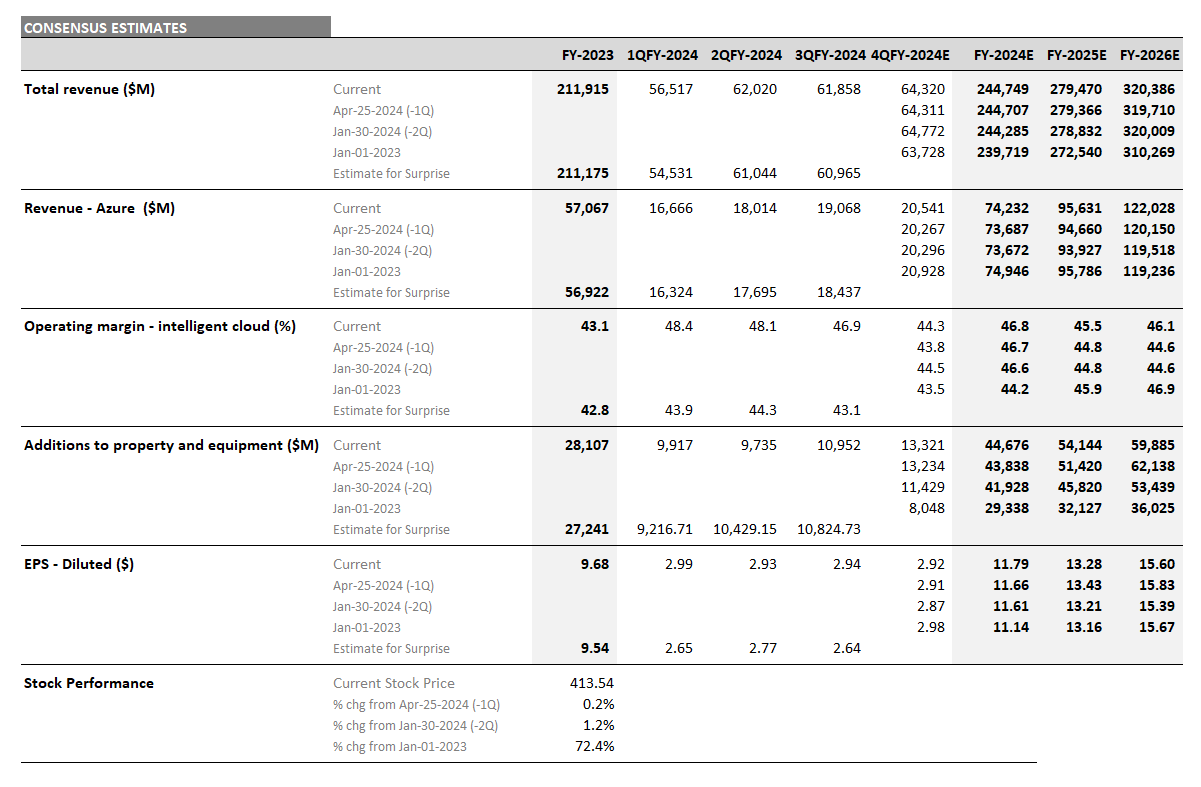
Source: Visible Alpha consensus (May 7, 2024). Stock price data courtesy of FactSet. MSFT’s current stock price is as of the market close on May 6, 2024.
Figure 4: Microsoft consensus estimates
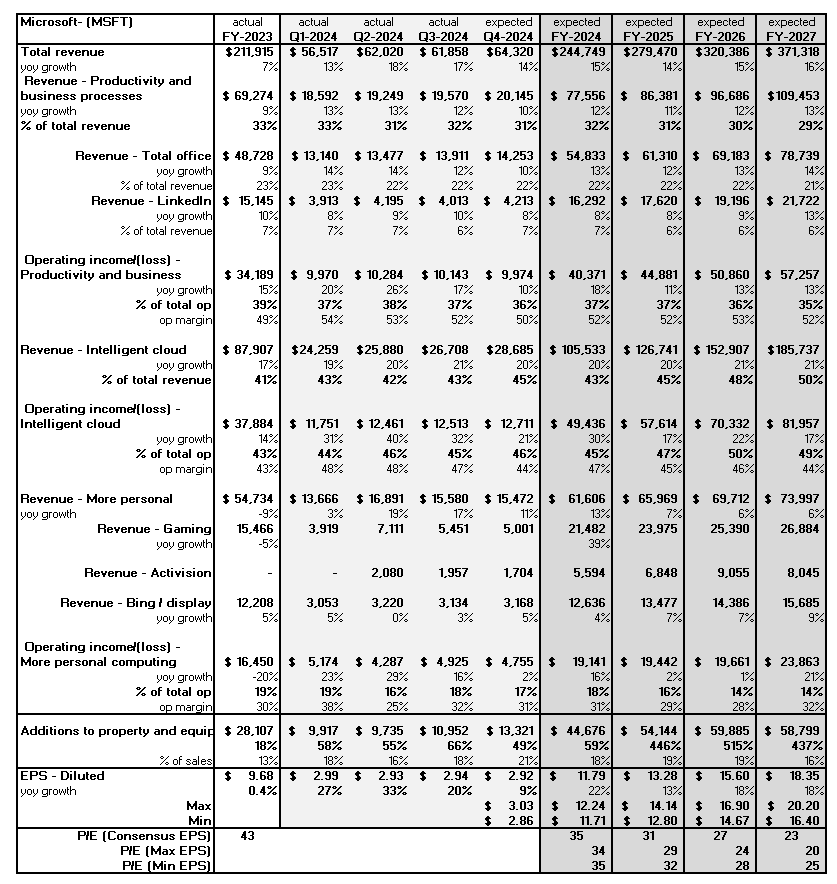
Source: Visible Alpha consensus (May 7, 2024). Stock price data courtesy of FactSet. MSFT’s current stock price is as of the market close on May 6, 2024.
Alphabet’s Q1 2024 earnings
According to Visible Alpha consensus, total revenues for Q1 2024 beat expectations by $1.5 billion, coming in at $80.5 billion, driven by resilience in the Search and YouTube businesses. The sentiment around profitability started improving ahead of the Q1, but Alphabet beat expectations for operating income by $3 billion, delivering $25 billion. Stronger-than-expected profitability in both the Services and Cloud segments led to the surprise.
We have been closely monitoring the profitability trend of the Cloud business, which delivered $33 billion in revenue and a 5% margin in 2023. Ahead of Q1 2024, analyst expectations for the Cloud business margin moved down 140 basis points since January 2024 to a 7.3% operating profit margin. However, the company beat the top-end estimate and delivered a strong 9.4% margin, driven by increases in average revenue per seat. As a result of the strong margin this quarter, analysts revised up estimates by 130 bps and now expect the Cloud business operating profit margin to jump to 9.8% for FY 2024, driven by increased profitability, especially in H2 2024. Longer term, the Cloud business is now projected to hit a 15% margin by FY 2026. Is this expectation achievable?
Alphabet stock has traded up 6% since last quarter’s release and is up 11% since the beginning of the year, outperforming the S&P 500. The stock has reacted positively to the resilience in its core service business and the improving profitability potential of the cloud business. In addition, the company issued a $0.20 share dividend and a $70 billion buyback.
Figure 5: Alphabet revisions
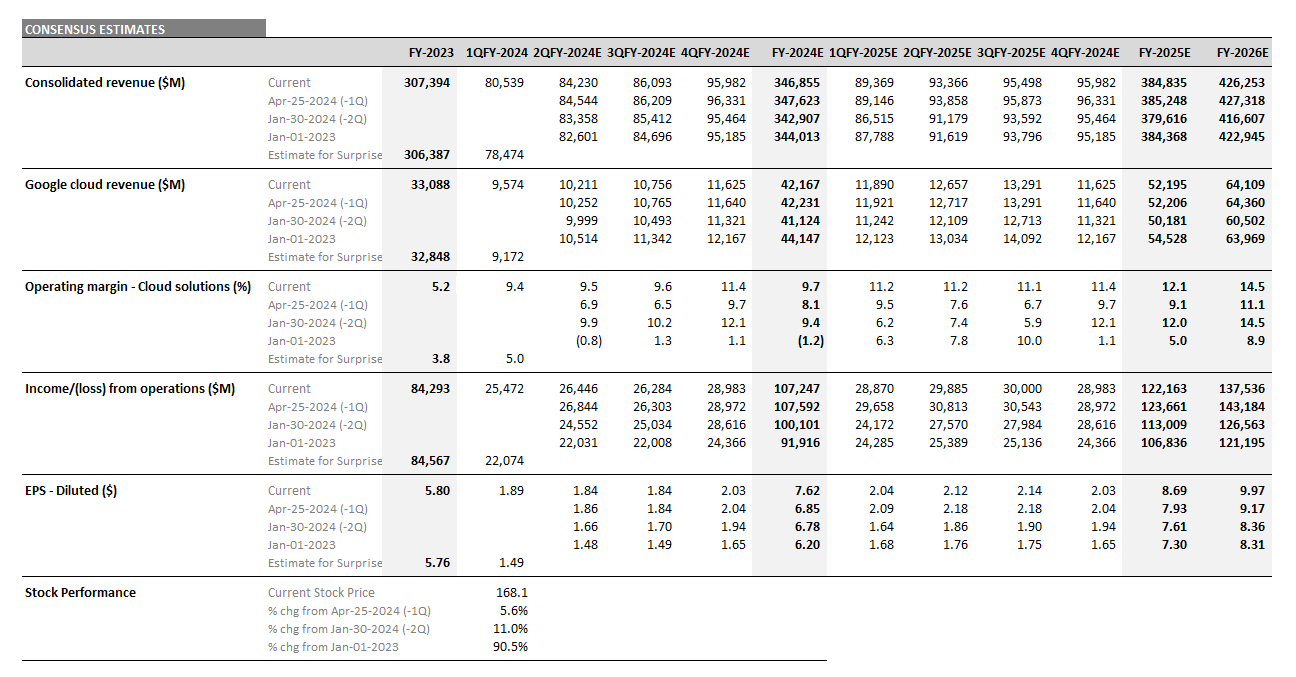
Source: Visible Alpha consensus (May 7, 2024). Stock price data courtesy of FactSet. GOOGL’s current stock price is as of the market close on May 6, 2024.
Figure 6: Alphabet consensus estimates
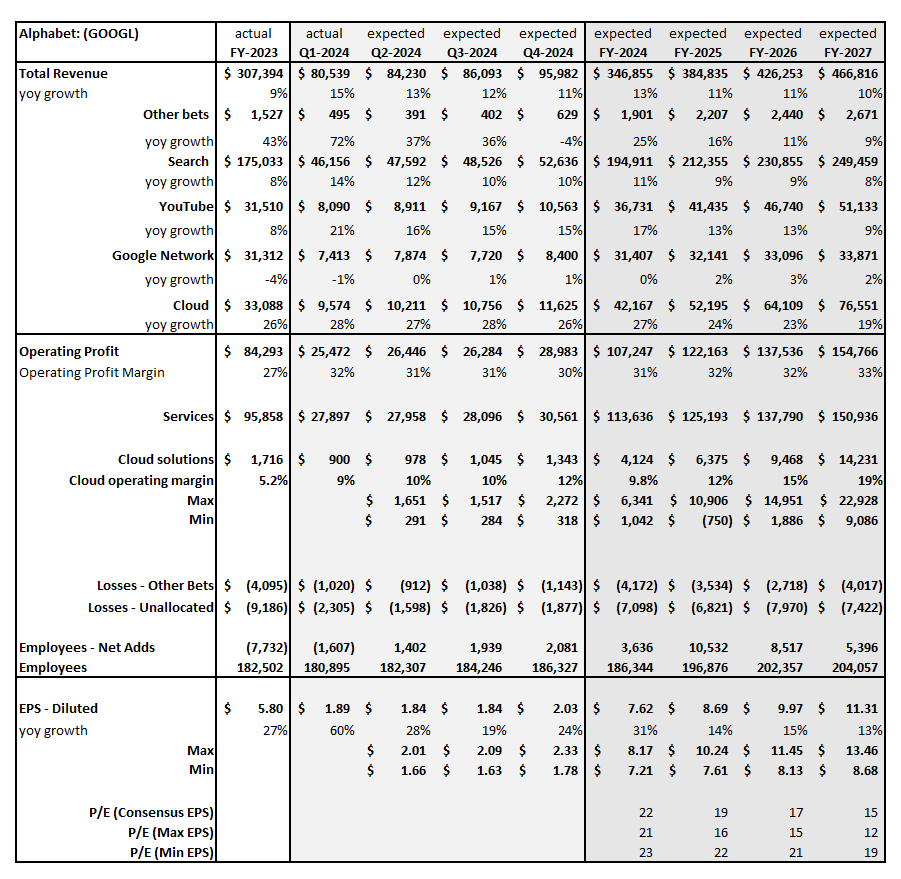
Source: Visible Alpha consensus (May 7, 2024). Stock price data courtesy of FactSet. GOOGL’s current stock price is as of the market close on May 6, 2024.
Amazon’s Q1 2024 earnings
Total revenues for Q1 beat expectations by almost $1 billion. Estimates were already moving higher ahead of the quarter, but ended up exceeding the higher end, driven by resilience in Amazon’s North America retail, advertising, and AWS businesses. The strong performance and outlook for the online retail and AWS margins were positive.
The North America retail operating margin has increased significantly to 4.2% in 2023 from losses in 2022. In Q1, the retail margin was at the 5% level, supporting consensus to move to a more upbeat 6-7% level outlook for the rest of 2024.
AWS margin came in very strong at 38% in Q1, well ahead of the consensus estimate of 29%, driven by a combination of managing costs and a change in the estimated useful life of their servers. For 2024, analysts are now expecting a 34% margin, up from 30% pre-Q1. The company expects a reacceleration in AWS growth and high demand for GAI.
The stock has traded up 8% since the Q1 release and 18% since the February release, outperforming the S&P 500. The company guided to revenue of $144-149 billion, slightly below consensus of $150.3 billion, and to operating profit of $10-14 billion, in line with consensus of $12.7 billion. Instead of rewarding shareholders with a dividend and/or buyback, the company opted to increase the pace of its infrastructure CapEx spend in 2024 to support growth in AWS from generative AI. Analysts expect CapEx for 2024 to be $65 billion and to increase further in 2025 to $70 billion, up significantly from $52 billion in 2023.
Figure 7: Amazon revisions
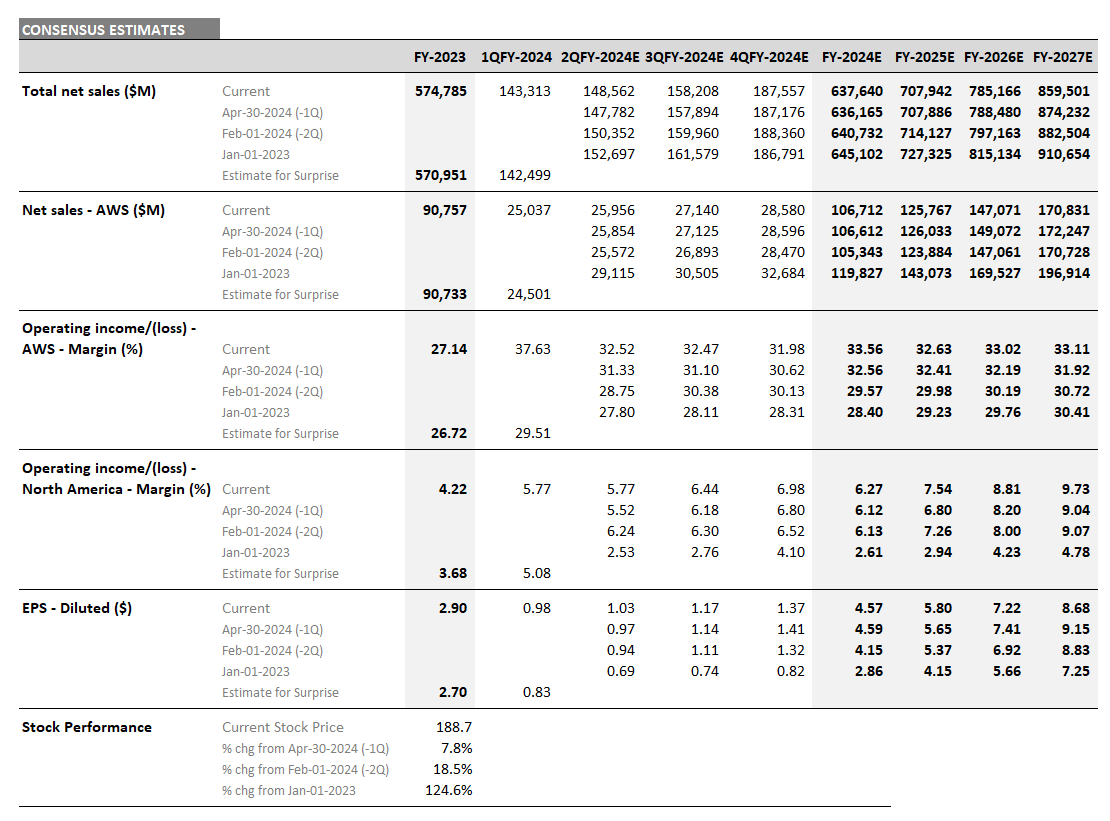
Source: Visible Alpha consensus (May 7, 2024). Stock price data courtesy of FactSet. AMZN’s current stock price is as of the market close on May 6, 2024.
Figure 8: Amazon consensus estimates
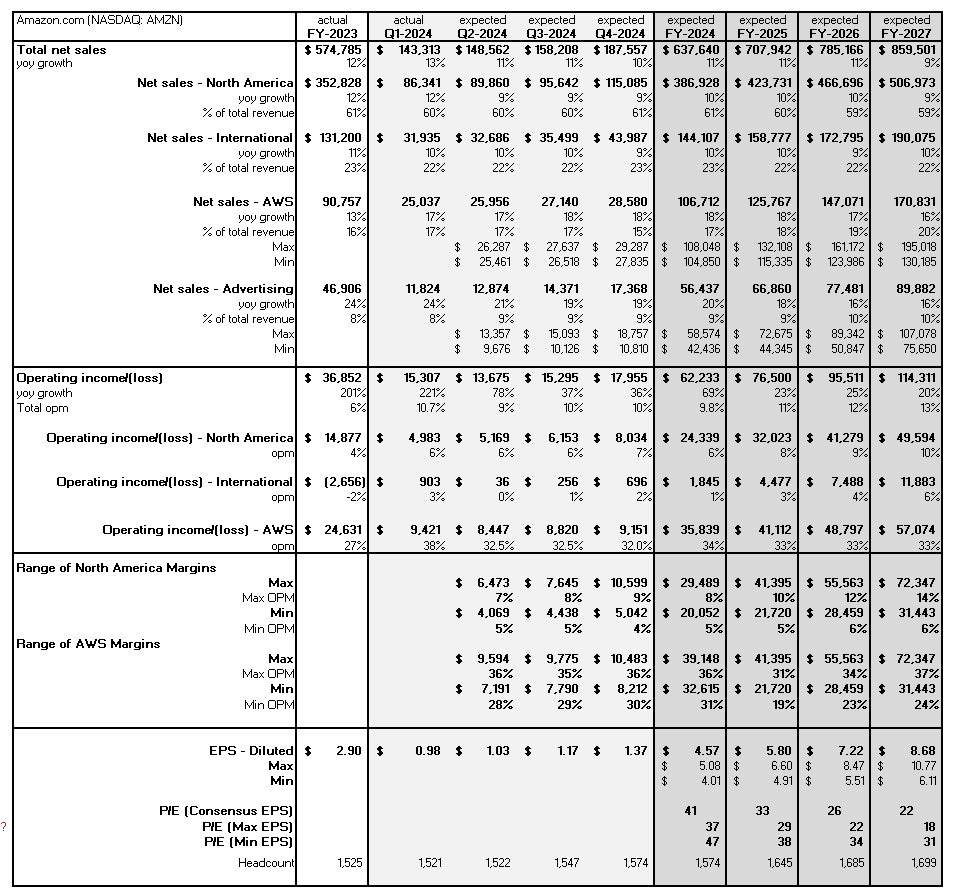
Source: Visible Alpha consensus (May 7, 2024). Stock price data courtesy of FactSet. AMZN’s current stock price is as of the market close on May 6, 2024.
Apple’s Fiscal Q2 2024 earnings
Total revenues for Q2 were in line with Visible Alpha consensus of $90 billion. Revenues of $46 billion from iPhone in Q2 were down 10% year-over-year, due to a strong compare last year. Based on consensus, Q2 iPhone 15 units were in line at 36 million, with estimates ranging from 29 million to 37 million units for Q3. Overall full-year iPhone revenue expectations have continued to trend down since January 2023. Currently, Q3 is expected to deliver $38 billion in iPhone sales and $197 billion for 2024, a small decrease post-Q2.
While iPhone sentiment has come down, expectations for the high-margin Services segment and for total operating profit have remained consistent. In Q2, the Services segment delivered $23.8 billion, up 14% year over year and ahead of consensus. Gross margin for the Services segment was up 180 bps quarter over quarter to 74.6%, significantly higher than the 36.6% gross margin for Products, which was down 280 bps sequentially. The company said that it is seeing increased customer engagement, with the Apple ecosystem supporting the future growth of the Services business. Based on consensus, Services is expected to hit $115 billion at the end of FY 2026, up $20 billion from this year’s estimate of $95.7 billion.
Vision Pro delivered its first set of results this quarter, in line with expectations. In Q2, Vision Pro sold 148,000 units, generating $487 million. For the full year, consensus revenue estimates for the Vision Pro have ticked up from an initial consensus projection of around $900 million to a current $1.25 billion.
The stock has traded up 5% since the Q2, but down 2.8% since last quarter’s release, underperforming the S&P 500, but outperforming more recently, driven by the increase in the dividend and significant share repurchases announced. Could Apple showcase something new with GAI at its upcoming Worldwide Developers Conference that may be a catalyst for the stock?
Figure 9: Apple revisions
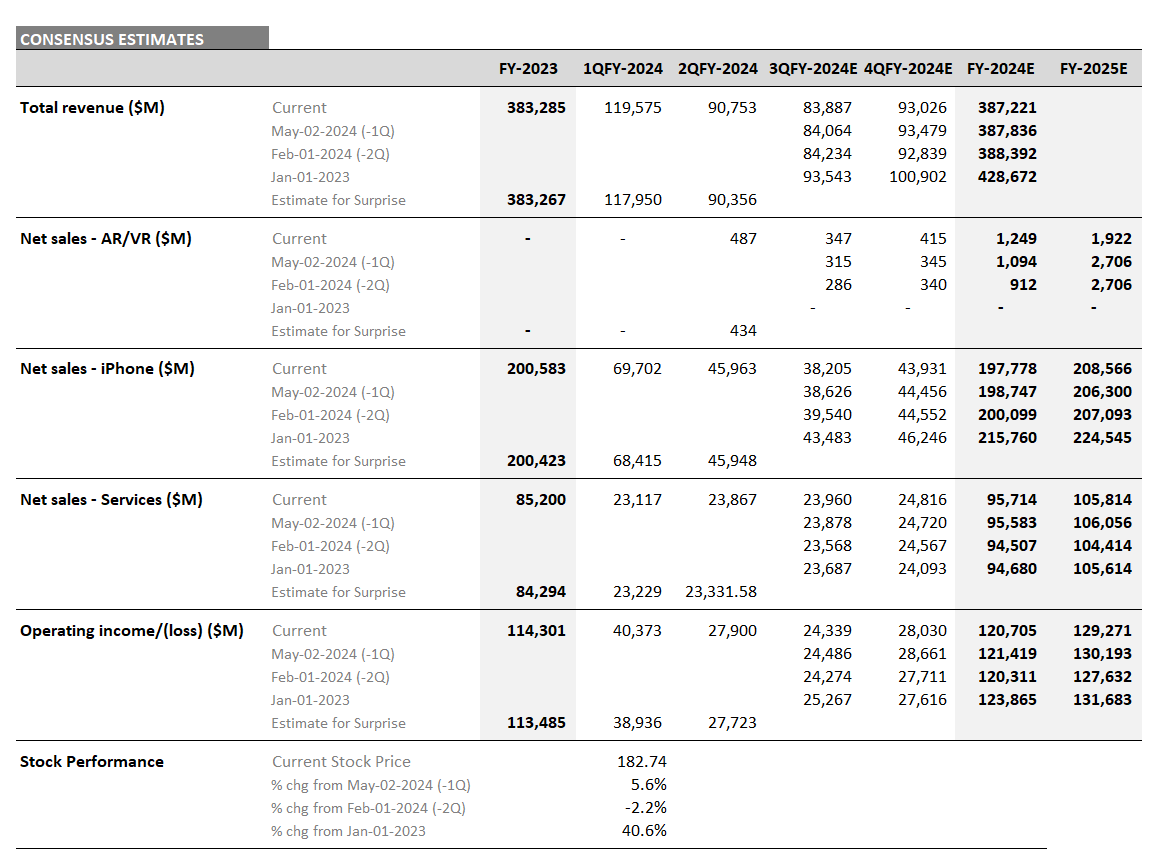
Source: Visible Alpha consensus (May 10, 2024). Stock price data courtesy of FactSet. AAPL’s current stock price is as of the market close on May 9, 2024.
Figure 10: Apple consensus estimates
Apple (AAPL) & Amazon (AMZN) Earnings Ahead
Apple (NASDAQ: AAPL) and Amazon (NASDAQ: AMZN) will report results next week. Here are the key numbers that we’re watching.
Apple’s Fiscal Q2 2024 Earnings Preview
Total revenues expected for fiscal Q2 have continued to come down from the beginning of last year, according to Visible Alpha consensus, from $103 billion to $90 billion, driven by decreased optimism about the iPhone. Expected Q2 iPhone 15 units range from 34 million to 40 million, with consensus at 36 million. Overall Q2 and full year iPhone revenue expectations have continued to trend down since January 2023. Currently, Q2 is expected to deliver $46 billion in iPhone sales and $199 billion for 2024.
While iPhone sentiment has come down, expectations for the high-margin Services segment and for total operating profit have remained consistent. Gross margin for the Services segment is over 70%, significantly higher than the 36% gross margin for Products. It will be helpful to hear what the company says in the earnings release about growth in Services and if this is enough to offset declines in iPhone sales.
Vision Pro will show its first set of results this quarter. In Q2, analysts estimate 127,000 units sold, generating $434 million. For the full year, consensus revenue estimates for the Vision Pro have ticked up recently from an initial projection of around $900 million to a current $1.1 billion.
The stock has traded down 10.7% since last quarter’s release, underperforming other Big Tech stocks and the S&P 500. Could the Q2 release provide a positive catalyst for the stock?
Figure 1: Apple – consensus expectations for Q2 2024, past earnings surprises, revisions, and CAGR

Source: Visible Alpha consensus (April 24, 2024). “Previous Surprises” indicate the direction that specific line items beat or missed. “Consensus Revisions” show the trajectory of line items from a given date.
Figure 2: Apple consensus estimates
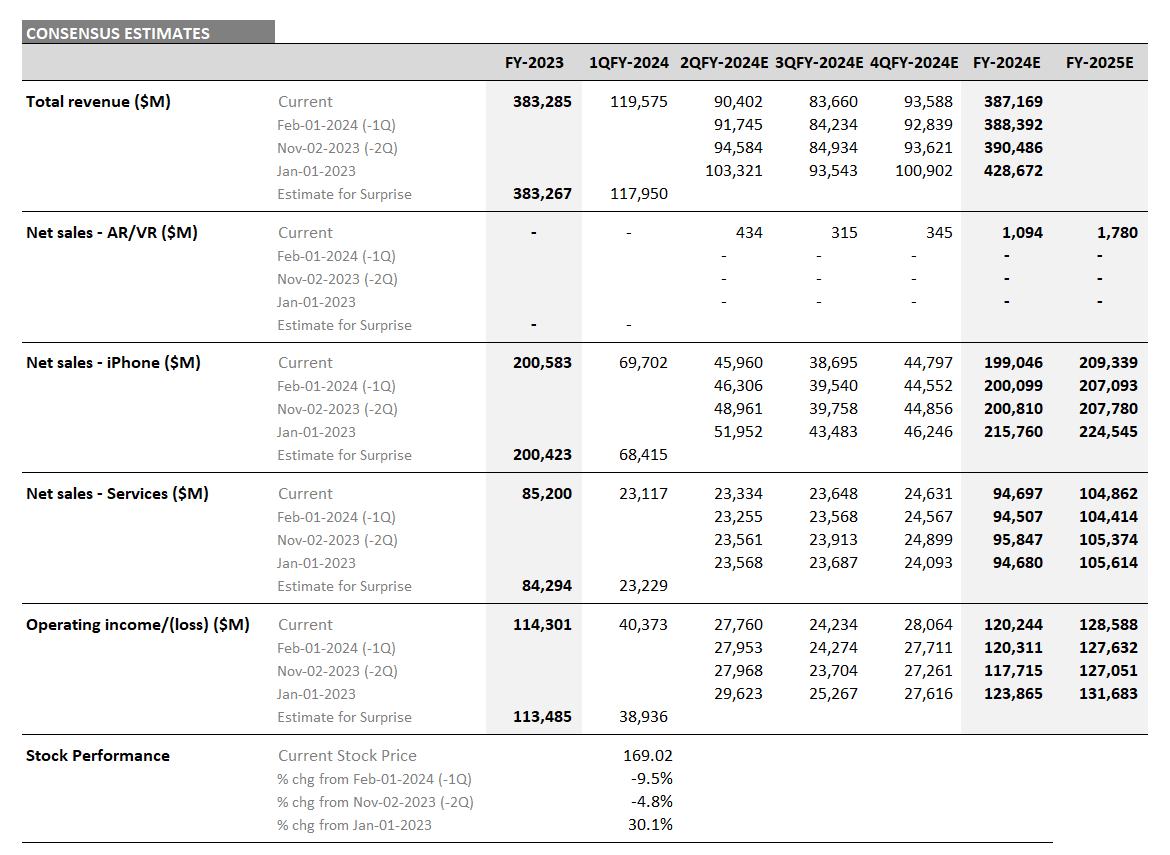
Source: Visible Alpha consensus (April 24, 2024). Stock price data courtesy of FactSet. AAPL’s current stock price is as of the market close on April 23, 2024.
Amazon’s Q1 2024 Earnings Preview
According to Visible Alpha consensus, total revenues expected for Q1 have come up slightly from Q4 2023, from $141.8 billion to $142.6 billion, driven by expected resilience in Amazon’s North America retail, advertising, and AWS businesses. The focus will likely be on the Q1 performance and outlook for the online retail and AWS margins, and their impact on EPS.
The North America retail operating margin has increased significantly from a meager 1.1% at the beginning of last year to 5% currently, ahead of Q1 earnings. Operating margin expectations for North America have been moving around since October, and considerable debate exists about the right level. For Q1 2024, the estimated margin ranges from 3% to 7%, with consensus at 5%. The current consensus 5% margin is slightly toned down from 5.3% earlier in the year. What will the company say about the outlook for the online business?
AWS margin came in at 27% last year and 29.6% last quarter. For Q1, analysts are expecting 29%. There is, however, a significant range of estimates for the Q1 AWS margin into next week’s release, with analysts expecting from 21-34%, an increase from the 24-31% range last quarter.
The stock has traded up 12% since last quarter’s release, outperforming the S&P 500. Could the Q1 release provide the next positive catalyst for the stock?
Figure 3: Amazon – consensus expectations for Q1 2024, past earnings surprises, revisions, and CAGR

Source: Visible Alpha consensus (April 24, 2024). “Previous Surprises” indicate the direction that specific line items beat or missed. “Consensus Revisions” show the trajectory of line items from a given date.
Figure 4: Amazon consensus estimates
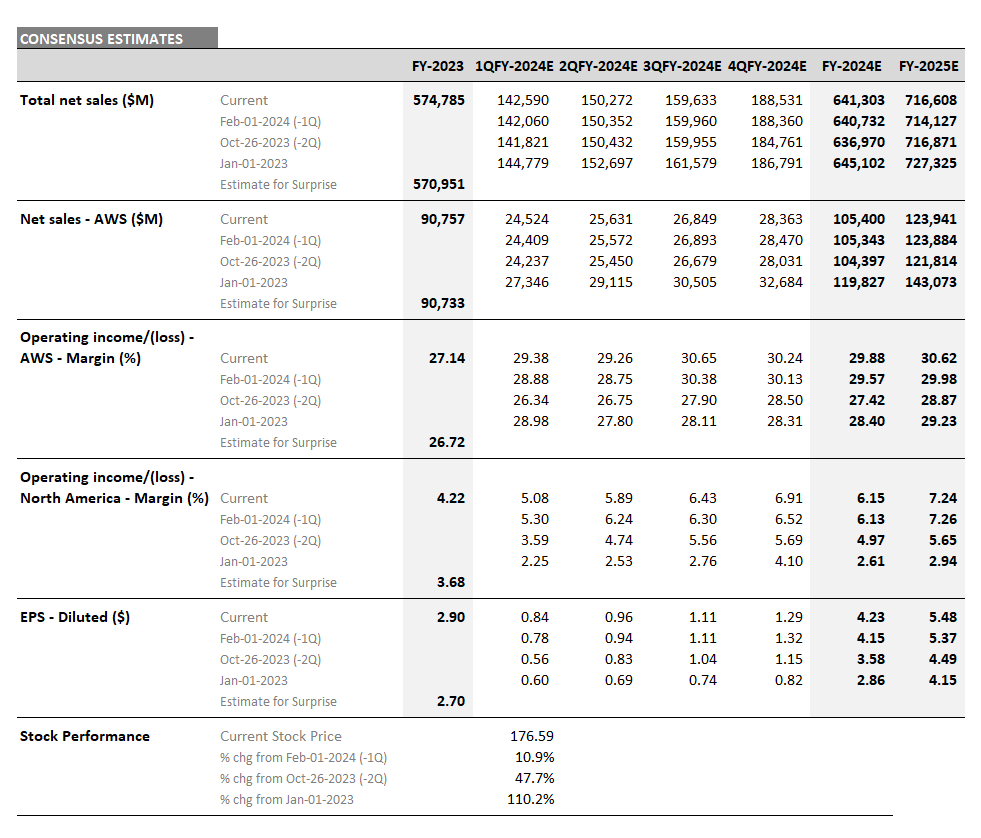
Source: Visible Alpha consensus (April 24, 2024). Stock price data courtesy of FactSet. AMZN’s current stock price is as of the market close on April 23, 2024.
The Visible Alpha AI Monitor: A Push Towards Enterprise Adoption
The Visible Alpha AI Monitor aggregates publicly-traded U.S. technology companies, providing a comprehensive measure of the current state and projected growth of the core AI industry. This encompasses the AI-exposed revenues for companies that are building AI infrastructure and capabilities for both enterprises and consumers.
Investors may use the Visible Alpha AI Monitor to generate new ideas to capture growth emanating from the core AI industry, as well as to evaluate the potential AI exposure of technology stocks in their existing portfolios. We have identified specific line items that capture potential growth of AI-related revenues that are available in the Visible Alpha Insights platform (see the goals, objectives, and methodology of the AI Monitor towards the bottom of this page).
The Visible Alpha AI Monitor: Generative AI adoption
The generative AI (GAI) trend gained momentum in 2023 as Cloud Service Providers invested heavily. In 2024, the GAI theme is continuing to evolve and gain momentum. This year looks poised to be the year of GAI adoption in enterprises. Visible Alpha is observing GAI make a greater push into organizations to drive efficiency and growth, while enhancing the client experience. The verdict is still out on whether or not GAI will yield real value for businesses and support stronger fundamentals and earnings growth. However, the trend toward GAI adoption is undeniable.
In Q1 2024, we added Autodesk, ServiceNow, Vertiv, Super Micro Computer, Crowdstrike, Lam Research and Broadcom to the AI Monitor universe, increasing from 63 to 69 companies. Alteryx was acquired and dropped out of the AI Monitor. Liveperson’s coverage dropped below our four-source threshold and will be removed next quarter.
Figure 1: AI growth and performance overview
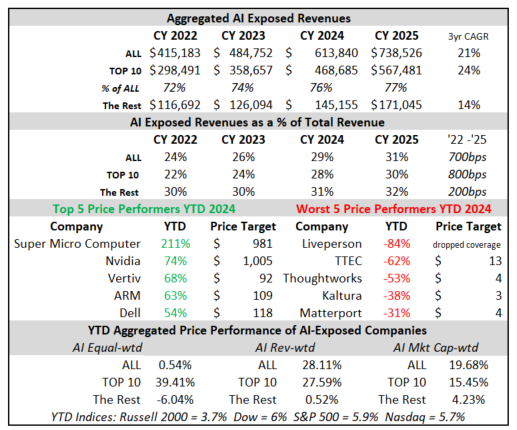
Source: Visible Alpha consensus (April 17, 2024). Stock price data courtesy of FactSet. Current stock prices are as of the market close on April 16, 2024. TOP 10 = IBM, Qualcomm, Oracle, Microsoft, Intel, Amazon, Super Micro Computer, Dell, Nvidia, Google. These firms currently have the largest revenue-generating segments geared to AI.
Visible Alpha 2024 Watchlist: 6 Companies to Watch in 2024
- Dell (NYSE: DELL) (new addition)
- Oracle (NYSE: ORCL)
- Microsoft (NASDAQ: MSFT)
- Snowflake (NYSE: SNOW)
- Sprinklr (NYSE: CXM)
- Zeta Global (NYSE: ZETA)
In 2024, we are watching the pace at which companies will be moving more of their data to the cloud and enabling innovation with AI. The AI Monitor aims to help users observe the pace of data migration to the cloud by highlighting companies and line items. In particular, we have been watching several companies since the beginning of the year.
We are closely tracking the performance of Oracle’s Cloud Services and Microsoft Azure’s Infrastructure and Platform as a Service businesses. Together, this partnership may bring more organizations to the cloud and position enterprises for integrating AI into their workflows. As enterprises shift to the cloud and look for end-to-end solutions to support working with generative AI, we have recently added Dell to our watchlist. Nvidia CEO Jensen Huang called out Dell CEO Michael Dell in the audience at Nvidia’s GTC (GPU Technology Conference) recently.
As more data goes into the cloud, we are also monitoring Snowflake’s growth. This stock is down over 30% since last quarter when it delivered lackluster guidance and changed CEOs. Snowflake enables organizations to de-silo their data and compare/share with other data sources across the enterprise, serving as a good starting point for leveraging AI across their enterprise. At a recent tech conference, Snowflake management said “the most common type of data going into Snowflake is CRM data.”
And as more customer relationship data moves to the cloud and into Snowflake for sharing between marketing, sales, and other teams, Sprinklr and Zeta Global may benefit from the need to unify and understand customer interactions.
As companies large and small establish their data, cloud, and AI strategies, what new innovations and companies will drive AI-exposed revenues in 2024 and beyond?
Updates to the AI Monitor
In 2023, eight out of the 10 largest AI-exposed revenue generators drove strong outperformance, while more than 50% of the smaller-cap AI stocks underperformed. Post-Q1, AI-exposed revenues are expected to grow by over $320 billion, from $415 billion at the end of 2022 to $739 billion at the end of 2025, driven overwhelmingly by the Top 10 largest in the AI Monitor.
Figure 2: AI-exposed revenue aggregations
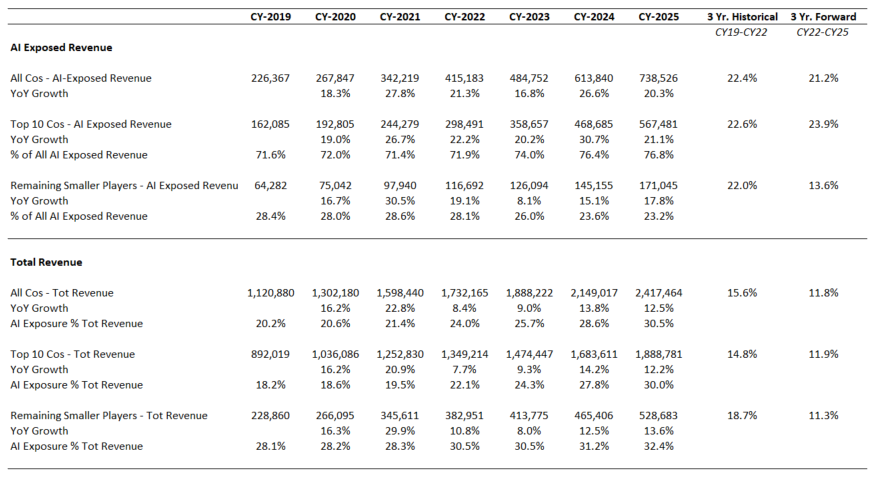
Source: Visible Alpha consensus (April 17, 2024). Stock price data courtesy of FactSet. Current stock prices are as of the market close on April 16, 2024. TOP 10 = IBM, Qualcomm, Oracle, Microsoft, Intel, Amazon, Super Micro Computer, Dell, Nvidia, Google. These firms currently have the largest revenue-generating segments geared to AI.
The revenue growth of the Top 10 is driven by the $230 billion of upward revisions analysts have made to Nvidia’s AI-exposed data center and Super Micro Computer’s AI-exposed server and storage systems revenues, which contributed significantly to both the AI-exposed revenue concentration and stock performance of the AI Monitor. Dell estimates for the AI-exposed Infrastructure Solutions Group revenues have come up nearly $9 billion for 2024 and 2025. How may these dynamics change through the rest of 2024?
New Additions to the AI Monitor
- Broadcom (NASDAQ: AVGO)
- Super Micro Computer (NASDAQ: SMCI)
- Vertiv (NYSE: VRT)
- ServiceNow (NYSE: NOW)
- Autodesk (NASDAQ: ADSK)
- Crowdstrike (NASDAQ: CRWD)
- Lam Research (NASDAQ: LRCX)
Figure 3: AI-exposed revenue revisions summary
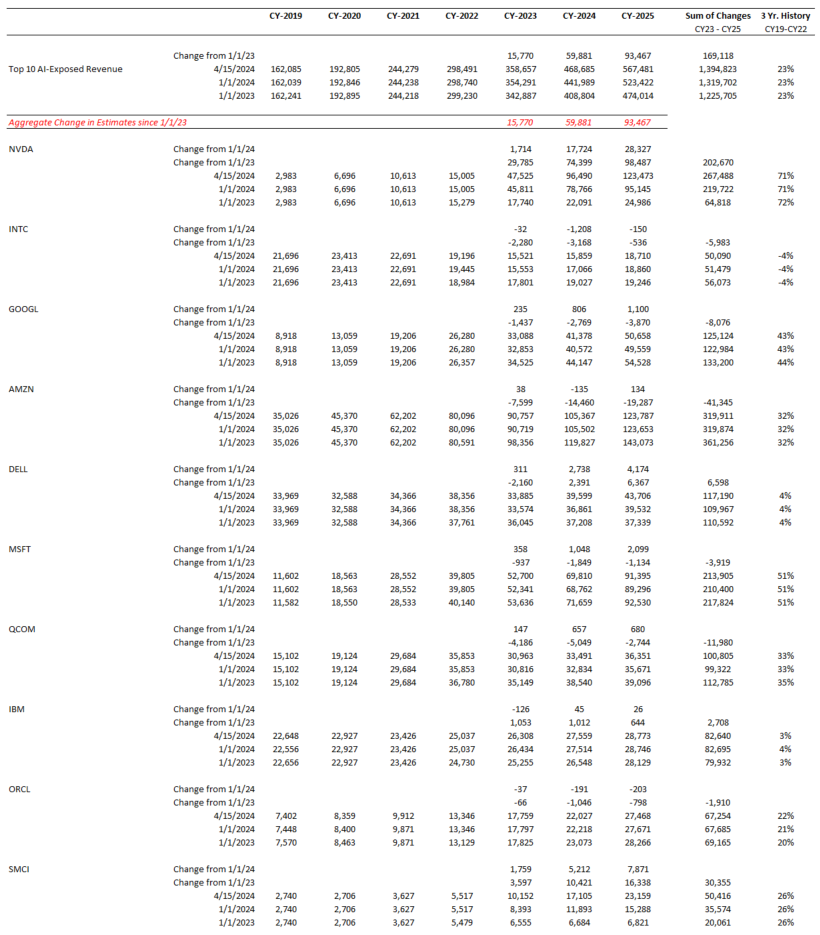
Source: Visible Alpha consensus (April 17, 2024). TOP 10 = IBM, Qualcomm, Oracle, Microsoft, Intel, Amazon, Super Micro Computer, Dell, Nvidia, Google. These firms currently have the largest revenue-generating segments geared to AI.
Oracle and Microsoft: How will this partnership help to drive cloud migration and AI in 2024 and 2025?
Access to data will be a critical dimension to anything a customer wants to do with AI. Back in the fall of 2023, Oracle CTO Larry Ellison and Microsoft CEO Satya Nadella explained that their partnership will enable customers to co-locate the Oracle hardware and software within the Azure Data Center, which will be key for fine-tuning, pre-training, or meta-prompting a model for AI.
With a large portion of data still located on-premise, they believe this collaboration should encourage companies to move to the cloud by lowering latency and increasing security. Once the data is in the cloud, customers can begin to innovate with it. From the Azure portal, users can provision an Oracle database, then marry that to Open AI and, ultimately, to the library of Microsoft technology.
Both Microsoft and Oracle estimates have ticked up since January. Currently, analysts are expecting Microsoft’s June 2024 Azure revenue to be $74 billion and to double to $149 billion by June 2027, driven by growth of Infrastructure and Platform as a Service businesses within Azure. Similarly, Oracle’s May 2024 revenue from Cloud Services is projected to double from $20 billion to nearly $39 billion by May 2027. Given the partnership, could the pace of this growth show up faster for both Microsoft’s Azure and Oracle’s Cloud Services business lines?
Snowflake
Speaking at a tech conference in December, Snowflake CFO Mike Scarpelli echoed points around the cloud, data, and AI that were similar to Oracle and Microsoft. He explained that to reap the benefits of generative AI, companies are going to use it in the cloud, instead of on-prem. Therefore, organizations will need to ensure their data is clean and in the cloud for their large language models to be useful.
As companies look to integrate AI into their organizations, the market for the Snowflake product looks poised to reaccelerate over the next year. However, the stock has declined over 30% since the disappointing guidance in March and the surprising CEO change. CEO Sridhar Ramaswamy brings the engineering lens to the role. The Q1 earnings call will likely set the stage for Ramaswamy and the stock. Could Q1 be a positive catalyst for the stock?
According to Visible Alpha consensus, revenues from product are estimated to be $3.3 billion in CY 2024 and grow now to $4.1 billion in CY 2025, down from last year’s $5.3 levels. The gross margin is projected to decline from 77.8% to 76.4% in FY 2025, driven by slower expected growth. There is currently debate about whether or not the guidance is conservative. The Q1 performance will likely set the tone for new CEO Sridhar Ramaswamy’s first year in the job.
According to Scarpelli, the most common type of data going into Snowflake is customer relationship management data. Therefore, we wanted to highlight two smaller-cap companies that are bringing AI innovations to their client’s marketing teams: Sprinklr and Zeta Global.
Sprinklr
Through its specialized AI models, Sprinklr aims to provide a unified customer-experience platform for tracking all the places a customer may interact with a company’s brand, especially on social media outlets. With a market cap of $3.1 billion, Sprinklr may benefit from any rotation to smaller-cap stocks that are benefiting from the AI theme and its growth trends.
Recently, the company has taken steps to improve operational visibility and address the challenges in its core business. According to Visible Alpha consensus, AI-exposed subscription revenue projections for CY 2024 have increased since last quarter, from $740 to $805 million, and for CY 2025, from $836 to $897 million. Given the renewed confidence in CY 2025 expectations, could Sprinklr rise above the challenges and beat consensus?
Zeta Global
With a market cap of $2.5 billion, Zeta Global is a smaller-cap company that looks well-positioned to benefit from its exposure to AI. Through the Zeta Marketing Platform (ZMP), COO Steve Gerber’s vision is to leverage their proprietary AI and data tools to unify identity, intelligence, and omnichannel activation into a single platform. Having clean data in the cloud for data sharing within organizations may become an increasingly important driver as customers look to centralize data for AI applications. Zeta Global’s partnership with data-sharing platform Snowflake may play a critical role in supporting the company’s growth.
According to Visible Alpha consensus, Zeta Global’s AI-exposed revenues are estimated to hit close to $1 billion by year-end 2025, from $709 million in CY 2023, as organizations adopt more advanced marketing technology.
Performance Summary
Currently, the Visible Alpha AI Monitor universe of 69 publicly traded U.S. companies is 76% weighted to the 10 largest companies, with the remaining 24% dispersed among 59 companies.
On a market-cap weighted and AI-exposed revenue-weighted basis, the Visible Alpha AI Monitor continues to be driven by substantial stock price outperformance (vs. the S&P 500 index) of the largest companies this year. In addition, the smaller companies are continuing to underperform (vs. the S&P 500 index), especially on an equal-weighted basis.
On an equal-weighted basis, the AI Monitor would have generated significantly lower return when compared to the market-cap and AI-exposed revenue-weighted aggregations this year, driven by the drag of a lower return generated by the smallest names.
Top 10
Based on an analysis of the 10 largest players, 2025 revenue forecasts for AI-exposed revenue segments increased $44 billion in total since January 2024. However, nearly $28 billion of the 2025 increase is from Nvidia, $8 billion from Super Micro Computer, and a further $4 billion increase from Dell. The declines in revenue estimates that the rest of the Top 10 has seen since January 2023 has largely stopped since the beginning of 2024. The downward revisions were driven by lower expectations for AWS, Google Cloud, and Qualcomm QCT. However, the estimates for these companies have moderated and in some cases, started to tick up, suggesting that the cuts to 2025 revenue expectations may have been too deep.
Smaller Contributors
The remaining list of 59 companies may serve as a good place for investors to discover new ideas by surfacing expanding new players. While smaller companies in aggregate have not performed as well as the Top 10, there have been some clear outperformers relative to the composite.
Among the smaller firms, revenue growth expectations are very mixed. Strong double-digit revenue growth is expected at some firms, while others are seeing estimates decline. These dynamics may help investors identify emerging trends in the space.
In 2023, we have already seen that to be true with Zeta Global, Pegasystems, and Informatica delivering strong outperformance (vs. the Russell 2000), which may help position these firms longer term as the up-and-comers in the space. Vertiv and Palantir are mid-caps with strong AI-exposed revenues and stock prices showing positive outperformance.
In contrast to these small-cap and mid-cap outperformers, more than half of the smaller companies in the AI Monitor substantially underperformed the Russell 2000 return of 3.7% YTD. This weakness may imply that these companies are under pressure and may be seeing compression in their valuations. This weakness may make some of these companies acquisition candidates by larger firms. TTEC, Thoughtworks, and Liveperson fell by more than 50% YTD in 2024, off significant declines in 2023.
Figure 4: AI Monitor aggregated stock return breakdowns

Source: Visible Alpha consensus (April 17, 2024). Stock price data courtesy of FactSet. Current stock prices are as of the market close on April 16, 2024. TOP 10 = IBM, Qualcomm, Oracle, Microsoft, Intel, Amazon, Super Micro Computer, Dell, Nvidia, Google. These firms currently have the largest revenue-generating segments geared to AI.
Figure 5: AI Monitor detailed breakdown
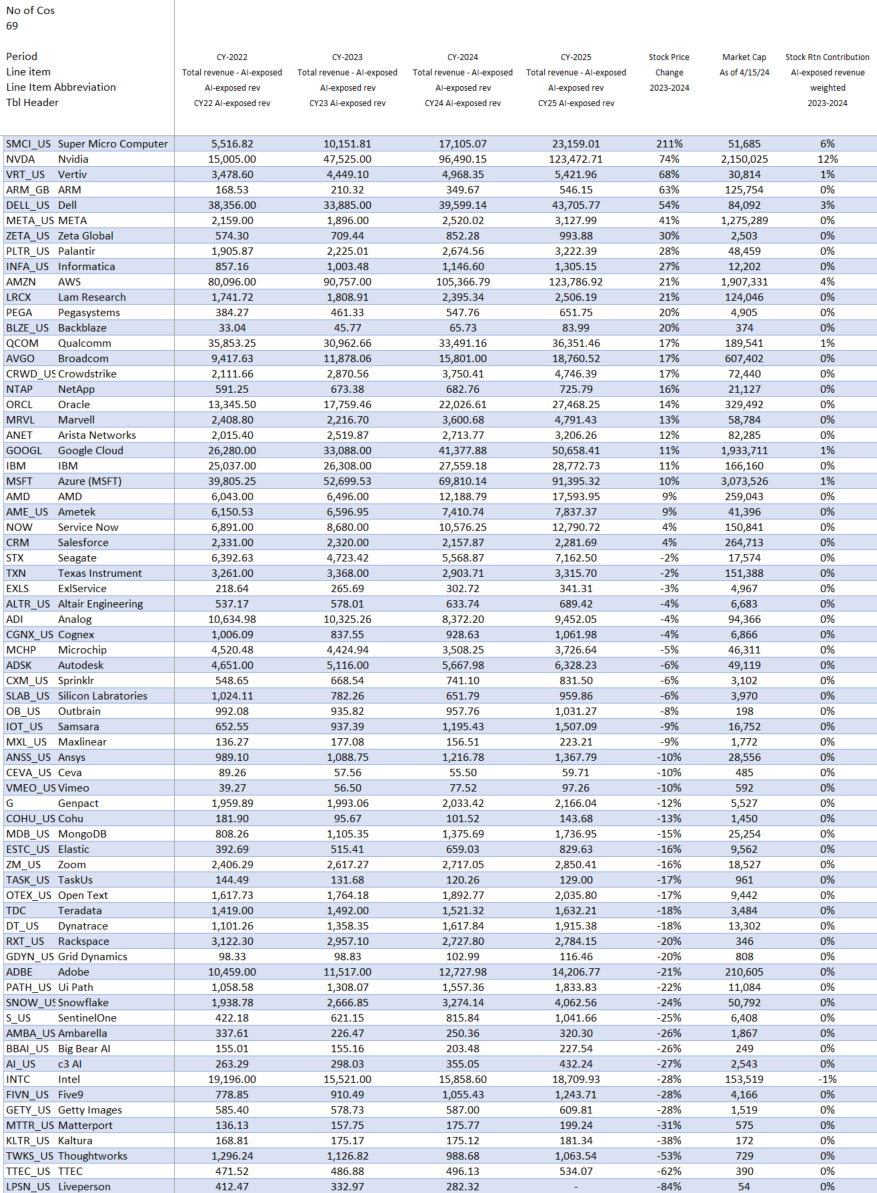
Source: Visible Alpha consensus (April 17, 2024). Stock price data courtesy of FactSet. Current stock prices are as of the market close on April 16, 2024. TOP 10 = IBM, Qualcomm, Oracle, Microsoft, Intel, Amazon, Super Micro Computer, Dell, Nvidia, Google. These firms currently have the largest revenue-generating segments geared to AI. Based on higher analyst counts, we are using the non-GAAP revenue number for Oracle and Ansys.
Regulatory Backdrop
The regulatory backdrop can have an impact on the potential adoption and growth of AI. Increased regulatory scrutiny is one potential obstacle to scaling GAI applications in organizations. In addition, there may be more regulatory hurdles around acquisitions that could bring about consolidation in the space. In the fall of 2023, President Biden issued an Executive Order to “ensure that America leads the way in seizing the promise and managing the risks of artificial intelligence (AI).” The Order contained initiatives to strengthen AI safety and security, privacy protections, innovation and competition, along with supporting consumers, workers, and equity. In January 2024, the agencies completed more than two dozen activities around AI talent, risks, and implications for the U.S. In addition, the White House has created a blueprint for an AI Bill of Rights (ai.gov).
As the government continues to focus on AI and its implications for the U.S., Stanford University released an update in April 2024 to its AI Index. The report captures the number of new AI-related regulations by agency in 2023 and shows the surge in proposed bills. The trajectory of the proposed regulations suggests we may see more regulations in 2024 and 2025. In addition, a wider range of agencies may be looking to add specific regulations going forward.
Figure 6: Proposed AI-related regulations by agency in the U.S.
Figure 7: U.S. AI-related regulations by agency
Final Thoughts
In 2024, Nvidia continues to lead in the space. However, Super Micro Computer is the best performer so far this year. Vertiv, ARM, and Dell have emerged as this year’s big performers year to date as the industry looks for scalable infrastructure solutions. These firms have surpassed last year’s winners, Palantir, Samsara, and C3 AI, which saw their exposure to AI translate into meaningful stock outperformance in 2023 relative to the S&P 500 index. The focus seems to be shifting from cloud service providers (CSPs) to scalable enterprise applications for GAI. For many firms, however, it is not clear how they will participate in bringing GAI to enterprises and grow the impact of AI-exposure in their business models.
In 2024, we are watching the pace at which companies will be moving more of their data to the cloud and enabling innovation with AI in enterprises. We are interested to see how the partnership between Oracle and Microsoft could help to drive more organizations to the cloud and set up their enterprises for integrating AI into their workflows. Through its data sharing and analytics capabilities, Snowflake is likely to play a role in the roll out of the AI ecosystem. Snowflake’s clients seem to be increasingly aiming to de-silo their data and organizations to understand how best to serve their customer base. As more customer relationship data moves to the cloud and into Snowflake for sharing and AI, it will be interesting to see if Zeta Global will continue to benefit from these dynamics happening in different parts of the tech stack.
Will Q1’s winners continue to drive the Visible Alpha AI Monitor for the rest of 2024?
AI Monitor Goals and ObjectivesThe objective of the Visible Alpha AI Monitor is to show the investment community which companies are likely to drive AI going forward. As the world embraces AI and its applications to enterprise workflows and our daily lives, big questions exist about how AI’s impact on company business models will unfold over the next 3-5 years. AI can potentially free people from tedious gruntwork to enable more focus on critical workflows that require human creativity and analysis. A primary goal of the Visible Alpha AI Monitor is to show which U.S. companies and specific line items we are keeping an eye on as the embryonic AI theme emerges across company fundamentals and begins to scale broadly across the economy. We are monitoring how AI may be reflected in the numbers and which companies may be benefitting more or less. This universe attempts to be comprehensive and to show investors the dynamics of both the large and smaller U.S. players. Additionally, it aims to help investors identify new names that may be smaller and less covered, but potentially growing and emerging more quickly. AI Monitor MethodologyUsing Visible Alpha’s comprehensive database of detailed estimates pulled directly from sell-side analysts’ spreadsheet models, we have assembled an aggregation with a universe of 69 publicly-traded companies that are contributing to the infrastructure and broad scaling of AI capabilities. This monitor aims to provide a current and future snapshot as to where AI-related revenues are and are not growing across each of these 69 companies, and particularly the 10 largest. We have aggregated the revenues of specific business segments at firms that are driving the wider AI trend. For larger firms, we have attempted to pinpoint where in their revenue model AI is driving growth. For some smaller firms, we are simply incorporating 100% of revenues. The AI-exposed revenue lines we identify are intended to be used as a proxy for monitoring the growth of each company’s AI business. Given both lack of discrete company disclosures and how intertwined AI and conventional technologies and services can be, these lines should not be taken as exact quantifications of AI revenues, but are, we believe, the best systematic approximation available. The AI Monitor provides three measures of stock performance for its universe. These metrics are meant to show the returns of various weighting schemes. The returns are calculated on both an equal-weighted and market-cap weighted basis. The universe performance of the AI Monitor is also weighted based on AI-exposed revenues and calculated in aggregate. From 2024, the return calculations were standardized and market-cap-weighted now reflects year-over-year changes. For Visible Alpha subscribers, details of these companies can all be found within the Visible Alpha Insights platform. Each company included in the monitor has coverage by at least four sell-side analysts. In addition, given the quickly evolving state of the AI space, these line items are subject to change and may shift significantly over time. We plan to refresh the data on an ongoing basis and provide regular updates. |
Meta, Microsoft, and Alphabet: April 2024 Earnings Previews
Meta Platforms (NASDAQ: META), Microsoft (NASDAQ: MSFT), and Alphabet (NASDAQ: GOOGL) will report results this week. Here are the key numbers that we’re watching.
Figure 1: Meta Platforms – consensus expectations for Q1 2024, past earnings surprises, revisions, and CAGR

Source: Visible Alpha consensus (April 19, 2024). “Previous Surprises” indicate the direction that specific line items beat or missed. “Consensus Revisions” show the trajectory of line items from a given date.
Figure 2: Meta Platforms consensus estimates
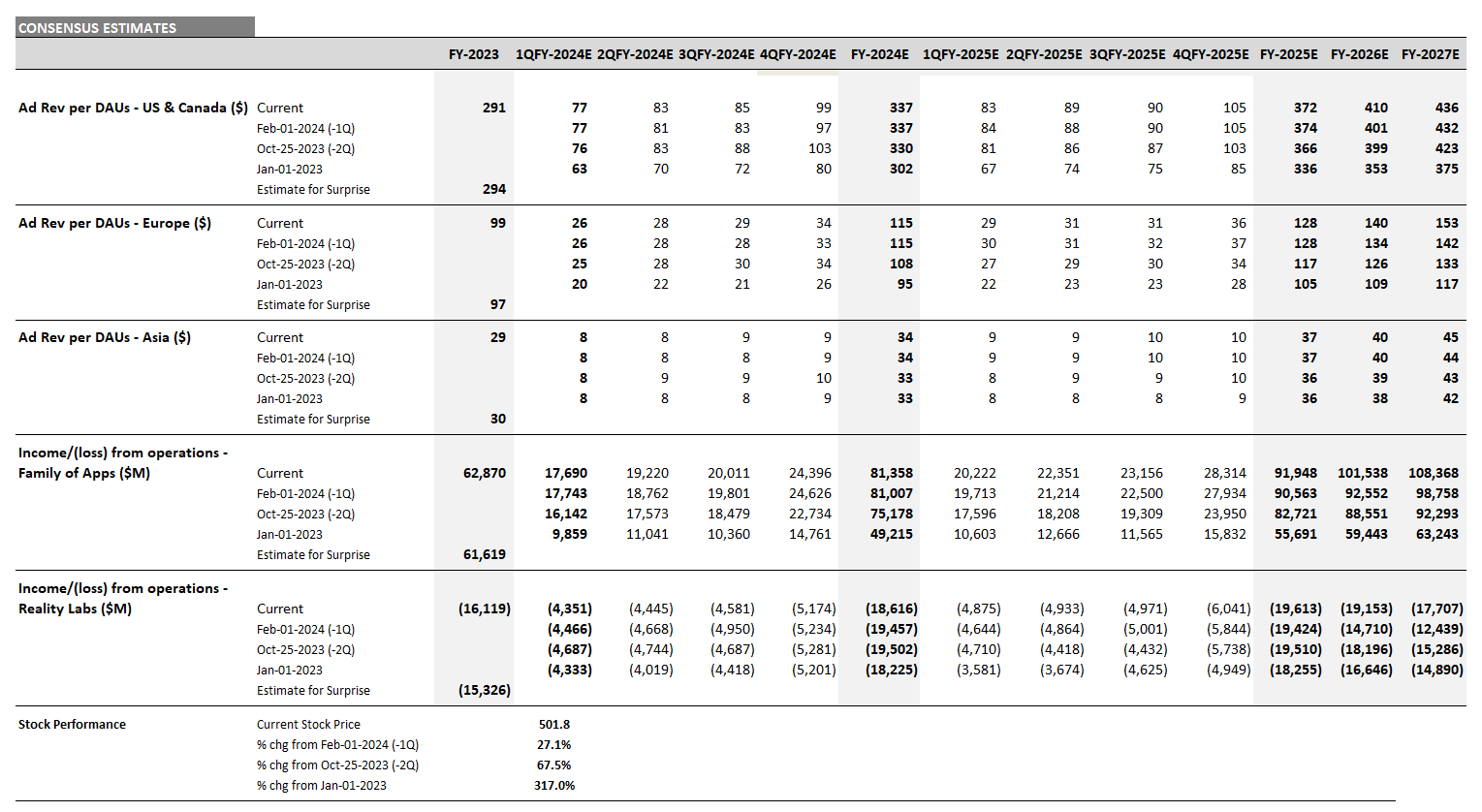
Source: Visible Alpha consensus (April 19, 2024). Stock price data courtesy of FactSet. META’s current stock price is as of the market close on April 18, 2024.
Meta Platforms Q1 2024 Earnings Preview
According to Visible Alpha consensus, total revenues expected for Q1 have moved up to $36.3 billion, driven by better performance in the Family of Apps segment, especially in the U.S. and Europe. However, expectations for operating profit have remained at $17.7 billion since Q4 2023. There is some debate among the analysts into Q1 for the Family of Apps’ income from operations, with estimates ranging from $16.0 billion to $19.4 billion.
For 2024, expectations for operating income from the Family of Apps have remained at $81.3 billion since last quarter, driven by continued efficiency in the business. In addition to the continued expected efficiencies in the Family of Apps segment, projected losses from Reality Labs for 2024 have decreased further since last quarter, suggesting efficiency is expected to continue to have an impact here too. Will Meta be able to continue managing costs in 2025?
The stock has been an outperformer since last quarter, up more than 27%. What new information will come out of the Q1 release that could potentially maintain the positive momentum?
Figure 3: Microsoft – consensus expectations for Q3 2024, past earnings surprises, revisions, and CAGR

Source: Visible Alpha consensus (April 19, 2024). “Previous Surprises” indicate the direction that specific line items beat or missed. “Consensus Revisions” show the trajectory of line items from a given date.
Figure 4: Microsoft consensus estimates
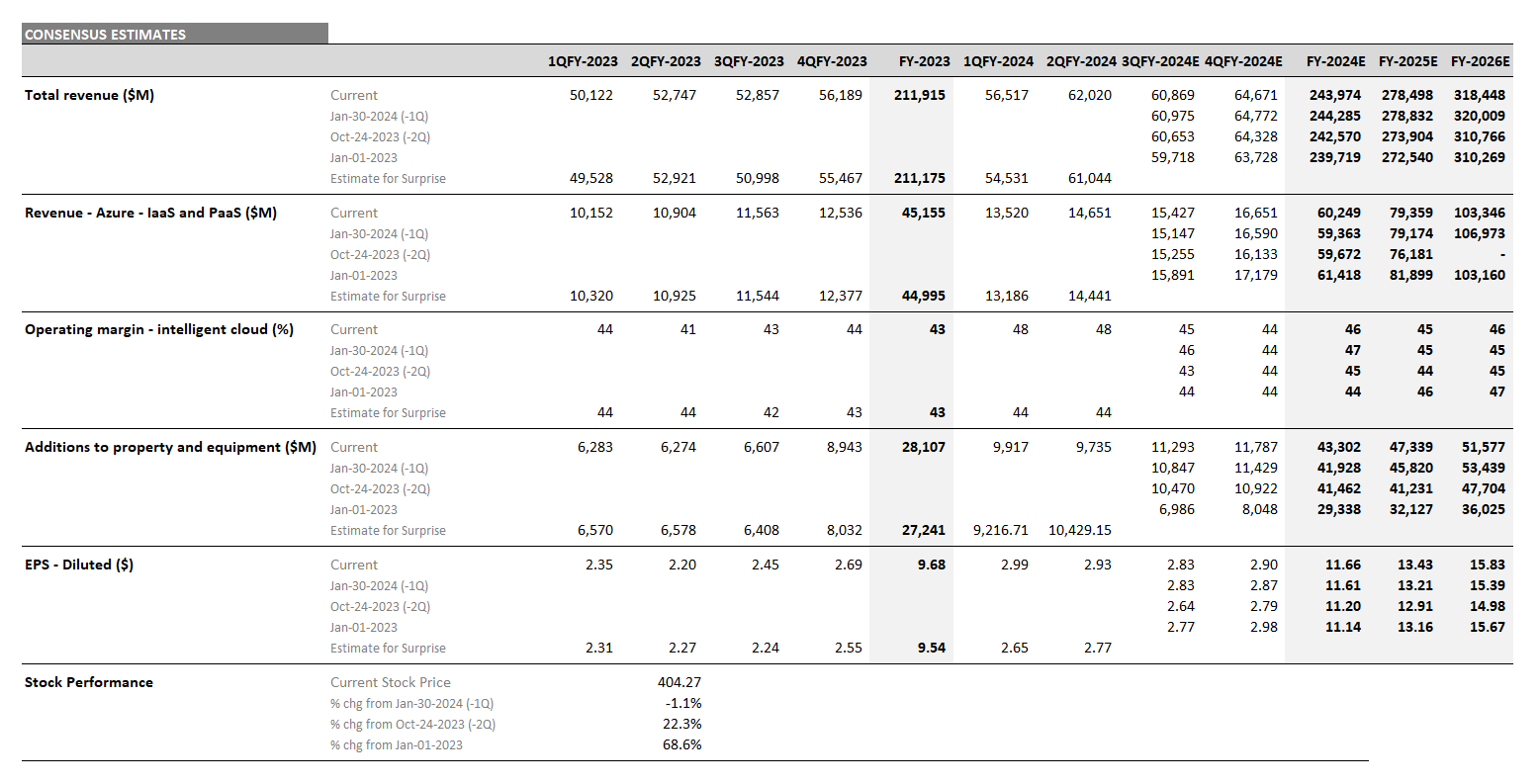
Source: Visible Alpha consensus (April 19, 2024). Stock price data courtesy of FactSet. MSFT’s current stock price is as of the market close on April 18, 2024.
Microsoft Q3 2024 Earnings Preview
According to Visible Alpha consensus, total revenues expected for Q3 have remained around $61 billion since October, driven by resilience in its core business segments. In particular, the Intelligent Cloud segment, which makes up over 40% of total revenues, is projected to remain solid, with consensus estimates around $105 billion for FY 2024, driven by Azure.
The profitability of the Intelligent Cloud segment is a source of debate among analysts. Currently, the Q3 2024 consensus of 14 analysts for the Intelligent Cloud business’s operating profit margin is 45%, but margin estimates range from 41% to 50%, suggesting this segment may deliver a surprise in the Q3 release. We are closely watching what the company will say about the outlook for AI and Copilot. Are the generative AI investments going to start to drive upside to fundamentals from this quarter?
CapEx numbers have continued to increase steadily since last year. According to consensus projections, CapEx estimates have climbed $15 billion from $28 billion in January 2023 to currently $43 billion for FY 2024, up 3x from FY 2019 and outpacing peers. We are also watching the Gaming segment, as the company fully integrates Activision. Analysts are expecting $5.1 billion in revenues this coming quarter and $21.3 billion for FY 2024. Will Microsoft start to invest more CapEx in the Gaming business?
Microsoft stock has traded down 1% since the last earnings release, but is up 8% year-to-date, outperforming the S&P 500. Could the Q3 release help drive further growth and momentum in the stock?
Figure 5: Alphabet – consensus expectations for Q1 2024, past earnings surprises, revisions, and CAGR

Source: Visible Alpha consensus (April 19, 2024). “Previous Surprises” indicate the direction that specific line items beat or missed. “Consensus Revisions” show the trajectory of line items from a given date.
Figure 6: Alphabet consensus estimates
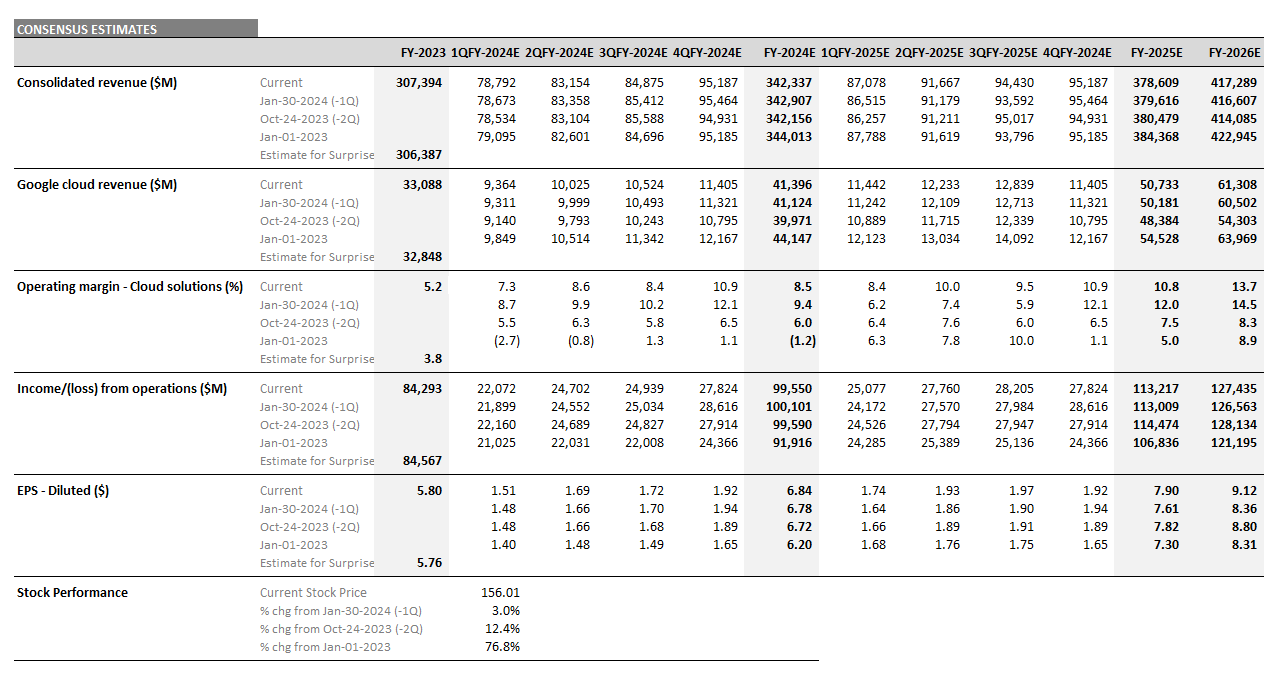
Source: Visible Alpha consensus (April 19, 2024). Stock price data courtesy of FactSet. GOOGL’s current stock price is as of the market close on April 18, 2024.
Alphabet Q1 2024 Earnings Preview
According to Visible Alpha consensus, total revenues expected for Q1 2024 have remained around $79 billion since January 2023, driven by resilience in its ad business. The sentiment around profitability appears to be improving, as the Q1 consensus expectations for operating income and EPS have ticked up to $22 billion and $1.51/share since January 2024.
We are closely monitoring the trend of the Cloud business, given the volatility in this business. The operating profit margin, which turned positive in Q1 2023 and showed further improvement in Q2, missed expectations in Q3 by 200 bps, but ultimately delivered a 5% margin for the year. Looking ahead to Q1 2024, analysts expect the Cloud business to generate a 7.3% operating profit margin, down 140 basis points since January 2024. However, analysts expect the Cloud business operating profit margin to jump to 8.5% in FY 2024, driven by increased profitability in H2 2024. Longer term, the Cloud business is projected to generate a 13.7% margin by FY 2026. Is this expectation still too high?
Alphabet stock has traded up 3% since last quarter’s release and up 12% since the beginning of the year, outperforming the S&P 500. The stock has remained resilient, driven by solid ad growth in its core business. However, questions remain about the profitability of the Cloud business and its Unallocated and Other Bets. Could the Q1 release provide more visibility into the trajectory of 2024 profitability?
Netflix (NFLX) Q1 2024 Earnings Preview
Netflix Inc. (NASDAQ: NFLX) will report Q1 2024 results on Thursday, April 18, 2024. Here are the key numbers that we’re watching.
Figure 1: Netflix – consensus expectations for Q1, past earnings surprises, revisions, and CAGR
Netflix Q1 2024 earnings preview
According to Visible Alpha consensus, total revenues of $9.3 billion and operating income of $2.4 billion expected for Q1 2024 have remained flattish from last quarter, driven by consistent expectations for U.S. streaming. Since last quarter, ad-supported revenue has also remained flattish at $135 million, but down over 50% from January 2023. While there does not appear to be a shift in expectations from the December quarter, questions remain around the investments in the ad tier, increased competition, and its impact on paid sharing.
The stock has traded up around 23% since last quarter’s December release and has remained higher (currently fluctuating above $600), close to its 52-week high of $639, driven by the resilience in the company’s net adds. Will the outlook for the rest of 2024 support the upward trajectory of Netflix’s stock price?
Figure 2: Netflix – consensus revenues, operating income, EPS, and stock performance
Will Google Cloud Achieve a Double-Digit Profit Margin in 2025?
Alphabet Inc.’s (NASDAQ: GOOGL) Google Cloud CEO, Thomas Kurian, kicked off the latest Google Cloud Next conference and Alphabet CEO, Sundar Pichai, provided an introduction that set the stage for discussing the rapid pace at which generative AI (GAI) is moving. What was announced in the keynote and what are the implications relating to potential margin expansion for Google Cloud?
Figure 1: Alphabet CEO Sundar Pichai at Google Cloud Next ‘24
Operating margin improvement
One of the key aspects of the Alphabet investment story is about Google Cloud continuing to improve its operating margin. This business broke even and generated a 5.2% operating profit margin in FY 2023, or $33 billion in revenue and $1.7 billion in operating profit. Based on Visible Alpha consensus, Google Cloud is now expected to generate an 8.5% operating margin, down from 9.1% in February, or $3.5 billion in operating income on $41 billion in revenue, by the end of FY 2024. However, there is significant debate about the Google Cloud business, with operating profit estimates ranging from $1 billion to $5.5 billion.
While the margin improvement for Google Cloud was positive in FY 2023, it remains far from the profitability of some of the company’s Cloud competitors, especially Microsoft. Microsoft delivered a 43% operating profit margin in its Intelligent Cloud business and Amazon’s AWS segment generated a 27% margin last year. In addition, Microsoft and Amazon AWS are each expected to see 200-300 basis points of margin improvement this fiscal year, according to Visible Alpha consensus.
At the Google Cloud Next 2024 conference, there seems to be a greater focus on showcasing how customers are using these new tools across various workflows. Kurian showed a spectrum of different agents with specific use cases for supporting customers, employees, and developers’ needs. Will the latest developments accelerate both revenue and operating profit growth in the Google Cloud business?
Figure 2: Google Cloud CEO Thomas Kurian introduces the CEO of Goldman Sachs
Goldman Sachs CEO David Solomon made a guest appearance at the Next conference. Solomon highlighted how generative AI at the bank is enabling business growth, enhancing client experience, and increasing efficiency. He concluded by stating that it “will yield real value for the business.”
Agents
Google Cloud also showcased Gemini 1.5 Pro and Vertex AI. The focus was on developing agents in enterprises for sales, service, and operational functions. Kurian highlighted that the Vertex AI agent builder can now create human-like conversations, use natural language instructions to control the conversation flow, and improve response quality with vector search.
Figure 3: Google Cloud CEO Thomas Kurian introduces the spectrum of Agents
Aparna Pappu, GM & VP of Google Workspace at Google Cloud, called out that companies are asking for cheaper AI-powered Google Meet and Chat to move away from Zoom, suggesting that the competition in the space may be intensifying. She highlighted that Google Meet outperformed Webex, Microsoft Teams, and Zoom in overall video and audio performance, and will cost $10/user/month. It is worth noting that Duet AI was charging $30/user/month last August. In addition, the company launched Google Vids, an AI-powered video creation app for Google Workspace.
These innovations are designed to add value to the user’s existing workflows by helping to make the user more efficient and productive with their existing tools. However, it is unclear how meaningfully these AI product innovations will drive revenues and profitability in the Google Cloud business segment, especially among small enterprise and individual users.
Google Cloud will need to deepen its monetization with all users to move the needle meaningfully on operating profit, which may prove challenging given Microsoft’s size and profitability in cloud and legacy workplace tools. Could these new Agents help to drive margin expansion for Google Cloud in FY 2024 and beyond?
Figure 4: Google Cloud consensus estimates
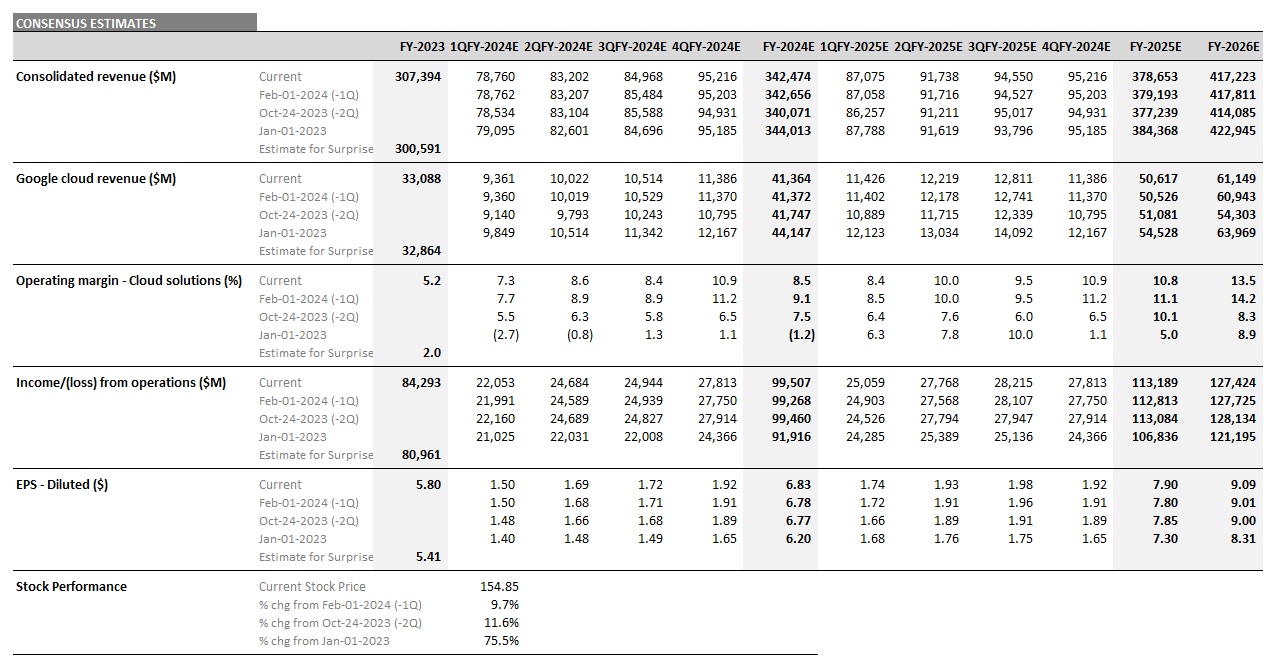
Source: Visible Alpha consensus (April 9, 2024). Stock price data courtesy of FactSet. Alphabet’s current stock price is as of the market close on April 8, 2024.
Figure 5: Alphabet’s key financial items
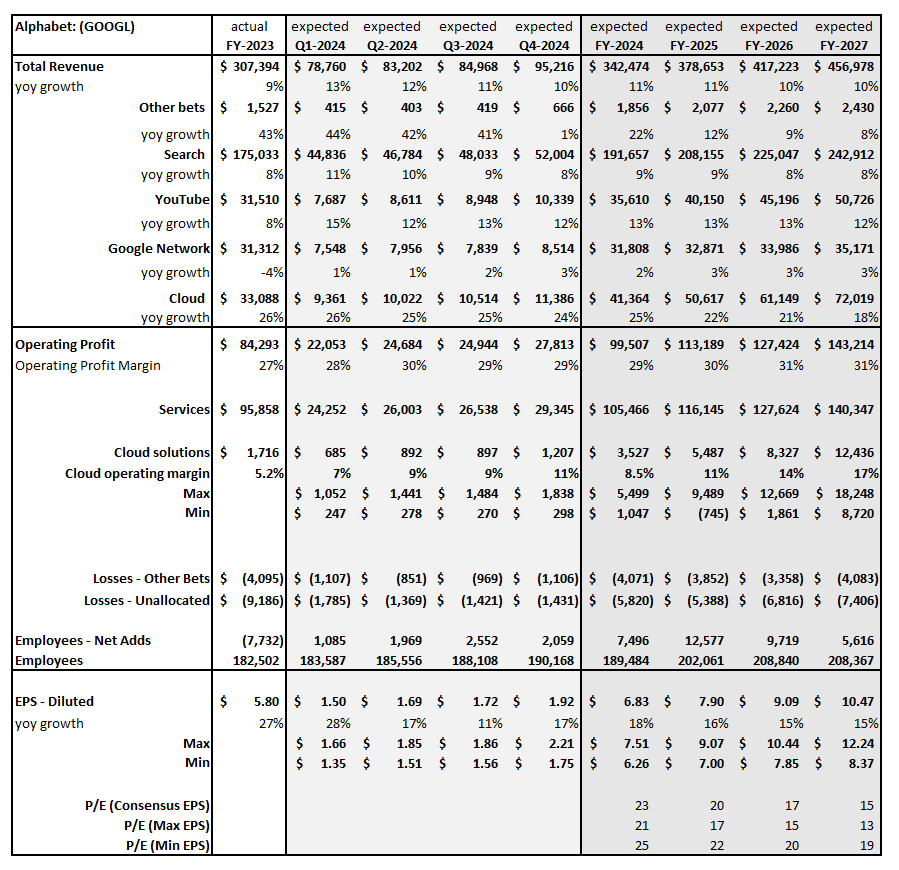
Source: Visible Alpha consensus (April 9, 2024). Stock price data courtesy of FactSet. Alphabet’s current stock price is as of the market close on April 8, 2024.
Final Thoughts
The development and adoption of GAI is in its infancy, but evolving quickly. Google Cloud seems poised to benefit from this technology shift. However, how the profitability of this business will ultimately shake out will be a critical long-term investment question for the stock. With the help of its Agents, will Google Cloud be able to carve out a more profitable place in the cloud landscape and move more quickly toward a double-digit operating profit margin?
Oracle Data and AI Forum
Oracle Corp. (NASDAQ: ORCL) hosted a Data and AI Forum on March 28, 2024. Here are some of our key observations from the forum.
Oracle Data and AI Forum
Oracle hosted a Data and AI Forum on Thursday, March 28, 2024. There were a host of speakers from both Oracle and its partners, including Nvidia. While many of the presentations had a sales angle to them, the event provided an insightful snapshot about the future for generative AI in enterprises.
Oracle shared a few interesting numbers from studies done by PWC and Grand View Research quantifying the impact of AI, estimating that AI’s predicted CAGR from 2023 to 2030 will be 37% and add $15.7 trillion to global GDP by 2030. Based on analysis from Insider Intelligence and ITU, Oracle highlighted that the adoption curve of AI has been much faster than smartphones and PCs.
The forum presentations highlighted the benefits of using Retrieval Augmented Generation (RAG), as it can move multi-modal data to production faster because it is not as prone to hallucinations. The process of adopting generative AI can help enterprises address data gaps, automate manual processes and simplify the organization. An important dimension to this transformation is that the AI prefers Remote Direct Memory Access (RDMA), as it provides a smoother experience moving from GPU to GPU. According to Oracle, RAG can enhance the overall accuracy of the generative AI experience and, as a result, has become increasingly adopted in enterprises.
This analysis suggests that momentum for generative AI adoption by enterprises may be stronger than current expectations. Based on Visible Alpha consensus, Oracle estimates for its Cloud businesses have been grinding back to levels expected in FY 2023. Could there be a catalyst on the horizon for further upside to these numbers?
Figure 1: The direction of Oracle estimates
Nvidia Post-GTC (GPU Technology Conference) 2024
Nvidia Corp. (NASDAQ: NVDA) hosted GTC (GPU Technology Conference) 2024, the company’s major AI conference for developers, in mid-March. Here are some of our key observations post-GTC.
Estimates continue to go up
Since GTC, analysts’ estimates have continued to grind higher. From January 1, 2023 to January 1, 2024, FY 2024 – FY 2027 aggregated Visible Alpha consensus expectations for Data Center revenues increased a whopping $250 billion, from $113 billion to $364 billion. Despite these enormous upward revisions, numbers are still moving up. From March 15, 2024, right before Nvidia’s GTC event kicked off on March 18, aggregated consensus increased a further $8 billion. Further optimism around the FY 2026 and FY 2027 outlook drove the bulk of the increases. What’s getting the investment community excited about the outlook?
Figure 1: Nvidia and Dell consensus estimates
Figure 2: CEO Jensen Huang: Moving toward an Industrial Revolution = $100 trillion
Birth of a new industry
According to CEO Jensen Huang at GTC, accelerated computing and Generative AI are moving the world to a new industrial revolution. While many of his comments echoed similar themes from his keynote at Computex 2023 in Taiwan last fall (see our report on that conference), he emphasized larger models, better performance and, ultimately, higher prices.
The move to accelerated computing is laying the groundwork and positioning heavy industry to scale innovative solutions in manufacturing. Omniverse Digital Twins will be able to simulate real world experiences and solutions that can help automotive and electronics manufacturers reduce risk and cost, while improving efficiency and creativity. The Omniverse enables everything to be manufactured digitally first.
Blackwell and Dell
Nvidia also announced the Blackwell platform at GTC. According to Huang, Blackwell will be “a very, very big GPU” for the Generative AI era. The combination of the FP4 Tensor Core, the new transformer engine, and the NVLink switch, which will enable GPUs to communicate with each other 10x faster, will support the proliferation of generative AI.
As organizations build out their chatbots and generative AI capabilities, Huang highlighted the need for an AI factory. In order to scale the generative AI capabilities across a full enterprise, firms are probably going to need to build AI factories. He then pointed to Michael Dell, CEO/founder of Dell, in the audience and explained that “nobody is better at building end-to-end systems of very large scale for the enterprise than Dell.” Has this been baked into Dell’s estimates?
Figure 3: CEO Jensen Huang: Blackwell
Longer-term, going higher?
For FY 2026, the range of estimates remains substantial and implies that there is significant debate about Nvidia’s growth outlook and whether the company will deliver the industrial revolution dream. The top-end estimate is currently at $182.6 billion, while the low-end estimate is at $95.8 billion for Data Center revenue. Non-GAAP diluted consensus EPS for FY 2026 is now projected to be $29.5/share, but ranges from $20.1/share to $41.9/share, with current P/E ratios at 39x to 19x. Will the gap close further and drive consensus estimates higher going forward?
NVDA stock has not reacted much since the GTC, but is up over 86% since the beginning of the year. Will the Data Center business continue to beat expectations in FY 2025 and continue to drive upside in the stock?





